Strategic positions Black & White Stock Photos
 1960s, golfer playing out of a hilly bunker on rough ground, England, UK. 'bunkers' are hazards or traps on a golf course filled with sand and are placed on a golf course in strategic positions to catch wayward shots and penalise a player. Stock Photohttps://www.alamy.com/image-license-details/?v=1https://www.alamy.com/1960s-golfer-playing-out-of-a-hilly-bunker-on-rough-ground-england-uk-bunkers-are-hazards-or-traps-on-a-golf-course-filled-with-sand-and-are-placed-on-a-golf-course-in-strategic-positions-to-catch-wayward-shots-and-penalise-a-player-image352720850.html
1960s, golfer playing out of a hilly bunker on rough ground, England, UK. 'bunkers' are hazards or traps on a golf course filled with sand and are placed on a golf course in strategic positions to catch wayward shots and penalise a player. Stock Photohttps://www.alamy.com/image-license-details/?v=1https://www.alamy.com/1960s-golfer-playing-out-of-a-hilly-bunker-on-rough-ground-england-uk-bunkers-are-hazards-or-traps-on-a-golf-course-filled-with-sand-and-are-placed-on-a-golf-course-in-strategic-positions-to-catch-wayward-shots-and-penalise-a-player-image352720850.htmlRM2BDRR16–1960s, golfer playing out of a hilly bunker on rough ground, England, UK. 'bunkers' are hazards or traps on a golf course filled with sand and are placed on a golf course in strategic positions to catch wayward shots and penalise a player.
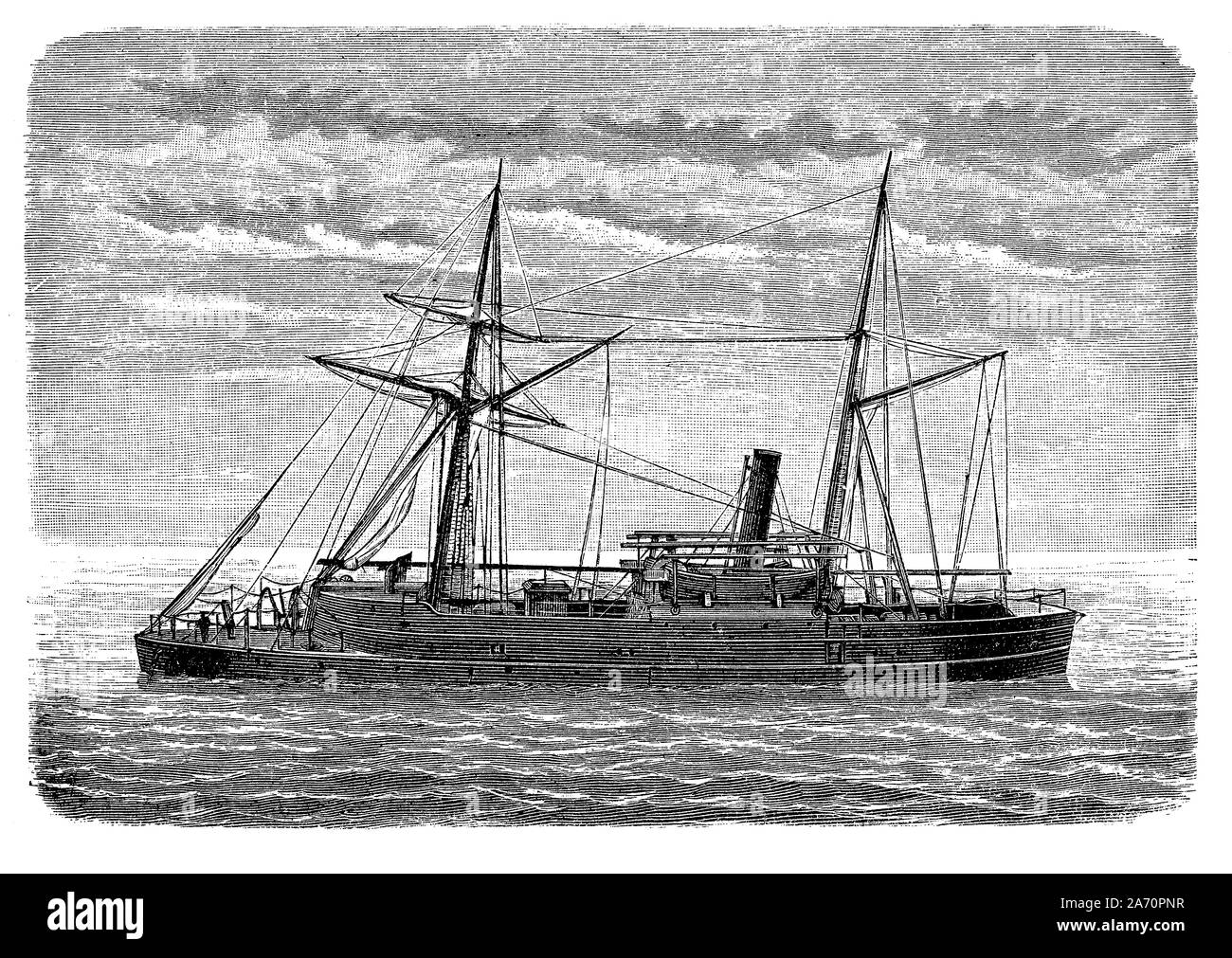 Chinese gunboat 19th century for cheap coastal defence, made of flat-iron or built from wood sheathed in iron Stock Photohttps://www.alamy.com/image-license-details/?v=1https://www.alamy.com/chinese-gunboat-19th-century-for-cheap-coastal-defence-made-of-flat-iron-or-built-from-wood-sheathed-in-iron-image331317443.html
Chinese gunboat 19th century for cheap coastal defence, made of flat-iron or built from wood sheathed in iron Stock Photohttps://www.alamy.com/image-license-details/?v=1https://www.alamy.com/chinese-gunboat-19th-century-for-cheap-coastal-defence-made-of-flat-iron-or-built-from-wood-sheathed-in-iron-image331317443.htmlRF2A70PNR–Chinese gunboat 19th century for cheap coastal defence, made of flat-iron or built from wood sheathed in iron
 'Major General Hoang Xuan Lam of the Second ARVN Division points out strategic positions to Lieutenant General Victor H. Krulak of FMFPac, during Operation Montgomery in Quang Ngai Province, RVN. This photo was taken on May 13, 1966, as part of a tour of First Marine Division facilities by General Krulak.' Stock Photohttps://www.alamy.com/image-license-details/?v=1https://www.alamy.com/major-general-hoang-xuan-lam-of-the-second-arvn-division-points-out-strategic-positions-to-lieutenant-general-victor-h-krulak-of-fmfpac-during-operation-montgomery-in-quang-ngai-province-rvn-this-photo-was-taken-on-may-13-1966-as-part-of-a-tour-of-first-marine-division-facilities-by-general-krulak-image574163109.html
'Major General Hoang Xuan Lam of the Second ARVN Division points out strategic positions to Lieutenant General Victor H. Krulak of FMFPac, during Operation Montgomery in Quang Ngai Province, RVN. This photo was taken on May 13, 1966, as part of a tour of First Marine Division facilities by General Krulak.' Stock Photohttps://www.alamy.com/image-license-details/?v=1https://www.alamy.com/major-general-hoang-xuan-lam-of-the-second-arvn-division-points-out-strategic-positions-to-lieutenant-general-victor-h-krulak-of-fmfpac-during-operation-montgomery-in-quang-ngai-province-rvn-this-photo-was-taken-on-may-13-1966-as-part-of-a-tour-of-first-marine-division-facilities-by-general-krulak-image574163109.htmlRM2TA3AW9–'Major General Hoang Xuan Lam of the Second ARVN Division points out strategic positions to Lieutenant General Victor H. Krulak of FMFPac, during Operation Montgomery in Quang Ngai Province, RVN. This photo was taken on May 13, 1966, as part of a tour of First Marine Division facilities by General Krulak.'
 Course for the Grand Prix of the Low Countries to Duindigt 1970 Start of hard-trotting; pikeurs on their sulies take strategic positions in Annotation: See also stock numbers: 923-6324, 923-6325, 923-6326 Date: June 28, 1970 Location: Den Haag, Duindigt, Zuid-Holland Keywords: trot- and racing, horse-and-wagon, horses, equestrian, sulky's Stock Photohttps://www.alamy.com/image-license-details/?v=1https://www.alamy.com/course-for-the-grand-prix-of-the-low-countries-to-duindigt-1970-start-of-hard-trotting-pikeurs-on-their-sulies-take-strategic-positions-in-annotation-see-also-stock-numbers-923-6324-923-6325-923-6326-date-june-28-1970-location-den-haag-duindigt-zuid-holland-keywords-trot-and-racing-horse-and-wagon-horses-equestrian-sulkys-image341686581.html
Course for the Grand Prix of the Low Countries to Duindigt 1970 Start of hard-trotting; pikeurs on their sulies take strategic positions in Annotation: See also stock numbers: 923-6324, 923-6325, 923-6326 Date: June 28, 1970 Location: Den Haag, Duindigt, Zuid-Holland Keywords: trot- and racing, horse-and-wagon, horses, equestrian, sulky's Stock Photohttps://www.alamy.com/image-license-details/?v=1https://www.alamy.com/course-for-the-grand-prix-of-the-low-countries-to-duindigt-1970-start-of-hard-trotting-pikeurs-on-their-sulies-take-strategic-positions-in-annotation-see-also-stock-numbers-923-6324-923-6325-923-6326-date-june-28-1970-location-den-haag-duindigt-zuid-holland-keywords-trot-and-racing-horse-and-wagon-horses-equestrian-sulkys-image341686581.htmlRM2ARW4M5–Course for the Grand Prix of the Low Countries to Duindigt 1970 Start of hard-trotting; pikeurs on their sulies take strategic positions in Annotation: See also stock numbers: 923-6324, 923-6325, 923-6326 Date: June 28, 1970 Location: Den Haag, Duindigt, Zuid-Holland Keywords: trot- and racing, horse-and-wagon, horses, equestrian, sulky's
 Plan of the fortifications of Columbus, Kentucky, and the surrounding strategic positions, from actual inspection. February 1862. 19th century American Civil War illustration from Frank Leslie's Illustrated Newspaper Stock Photohttps://www.alamy.com/image-license-details/?v=1https://www.alamy.com/plan-of-the-fortifications-of-columbus-kentucky-and-the-surrounding-strategic-positions-from-actual-inspection-february-1862-19th-century-american-civil-war-illustration-from-frank-leslies-illustrated-newspaper-image482985526.html
Plan of the fortifications of Columbus, Kentucky, and the surrounding strategic positions, from actual inspection. February 1862. 19th century American Civil War illustration from Frank Leslie's Illustrated Newspaper Stock Photohttps://www.alamy.com/image-license-details/?v=1https://www.alamy.com/plan-of-the-fortifications-of-columbus-kentucky-and-the-surrounding-strategic-positions-from-actual-inspection-february-1862-19th-century-american-civil-war-illustration-from-frank-leslies-illustrated-newspaper-image482985526.htmlRF2K1NTY2–Plan of the fortifications of Columbus, Kentucky, and the surrounding strategic positions, from actual inspection. February 1862. 19th century American Civil War illustration from Frank Leslie's Illustrated Newspaper
 During the occupation of the Ruhr, the French made sure to guard strategic key positions. Here tanks secure the main station in Essen. Stock Photohttps://www.alamy.com/image-license-details/?v=1https://www.alamy.com/during-the-occupation-of-the-ruhr-the-french-made-sure-to-guard-strategic-key-positions-here-tanks-secure-the-main-station-in-essen-image247161546.html
During the occupation of the Ruhr, the French made sure to guard strategic key positions. Here tanks secure the main station in Essen. Stock Photohttps://www.alamy.com/image-license-details/?v=1https://www.alamy.com/during-the-occupation-of-the-ruhr-the-french-made-sure-to-guard-strategic-key-positions-here-tanks-secure-the-main-station-in-essen-image247161546.htmlRMTA3522–During the occupation of the Ruhr, the French made sure to guard strategic key positions. Here tanks secure the main station in Essen.
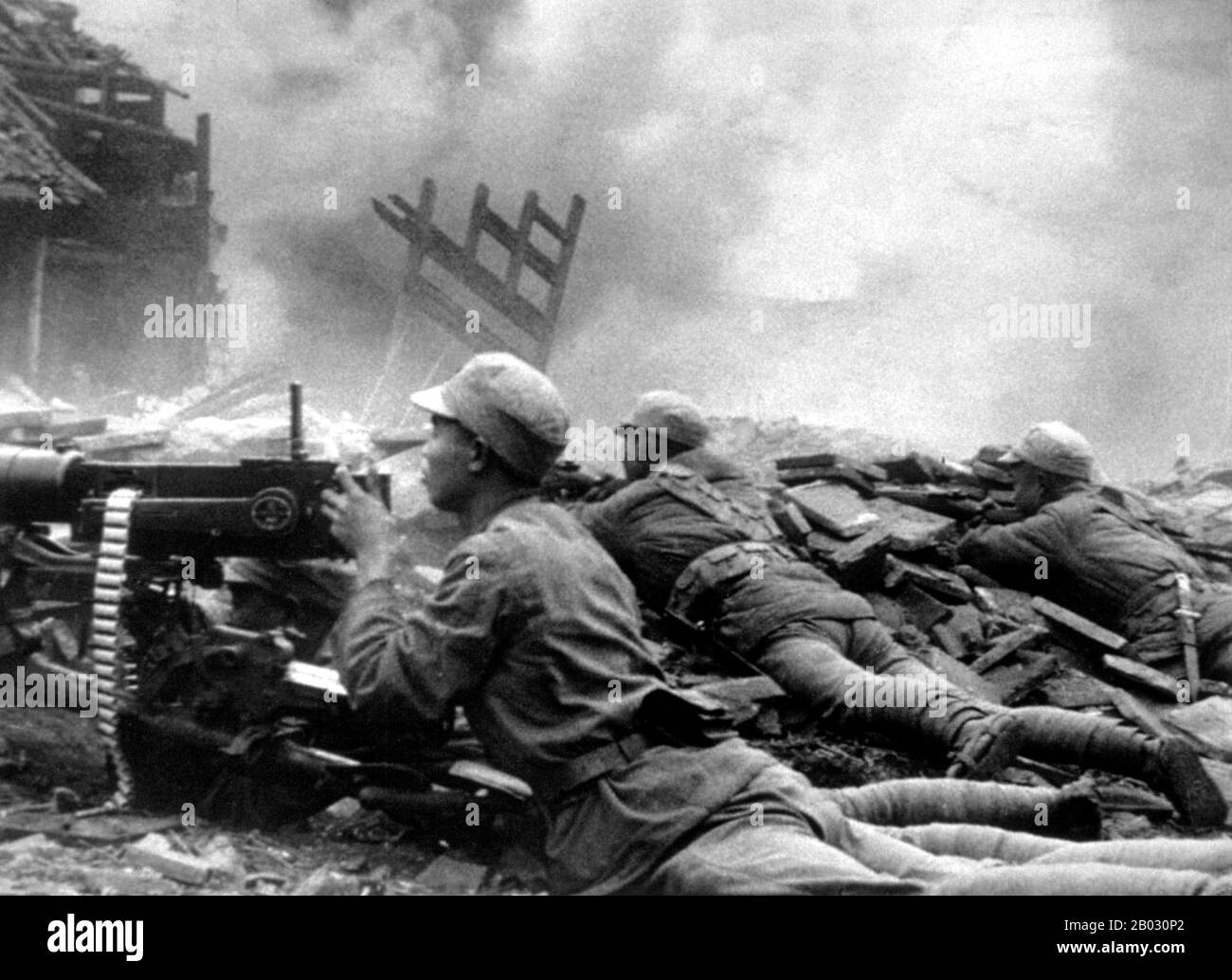 Chinese troops of the National Revolutionary Army fire on Japanese positions during the Battle of Changde, the strategic city in the heart of China’s rice-growing area. Although the Japanese army initially successfully captured the city, the Chinese 57th Division was able to pin them down long enough for reinforcements to arrive and encircle the Japanese. The Chinese Army then cut off the Japanese supply lines, forcing them into retreat. Changde, Hunan, Republic of China. November 1943. Stock Photohttps://www.alamy.com/image-license-details/?v=1https://www.alamy.com/chinese-troops-of-the-national-revolutionary-army-fire-on-japanese-positions-during-the-battle-of-changde-the-strategic-city-in-the-heart-of-chinas-rice-growing-area-although-the-japanese-army-initially-successfully-captured-the-city-the-chinese-57th-division-was-able-to-pin-them-down-long-enough-for-reinforcements-to-arrive-and-encircle-the-japanese-the-chinese-army-then-cut-off-the-japanese-supply-lines-forcing-them-into-retreat-changde-hunan-republic-of-china-november-1943-image344273834.html
Chinese troops of the National Revolutionary Army fire on Japanese positions during the Battle of Changde, the strategic city in the heart of China’s rice-growing area. Although the Japanese army initially successfully captured the city, the Chinese 57th Division was able to pin them down long enough for reinforcements to arrive and encircle the Japanese. The Chinese Army then cut off the Japanese supply lines, forcing them into retreat. Changde, Hunan, Republic of China. November 1943. Stock Photohttps://www.alamy.com/image-license-details/?v=1https://www.alamy.com/chinese-troops-of-the-national-revolutionary-army-fire-on-japanese-positions-during-the-battle-of-changde-the-strategic-city-in-the-heart-of-chinas-rice-growing-area-although-the-japanese-army-initially-successfully-captured-the-city-the-chinese-57th-division-was-able-to-pin-them-down-long-enough-for-reinforcements-to-arrive-and-encircle-the-japanese-the-chinese-army-then-cut-off-the-japanese-supply-lines-forcing-them-into-retreat-changde-hunan-republic-of-china-november-1943-image344273834.htmlRM2B030P2–Chinese troops of the National Revolutionary Army fire on Japanese positions during the Battle of Changde, the strategic city in the heart of China’s rice-growing area. Although the Japanese army initially successfully captured the city, the Chinese 57th Division was able to pin them down long enough for reinforcements to arrive and encircle the Japanese. The Chinese Army then cut off the Japanese supply lines, forcing them into retreat. Changde, Hunan, Republic of China. November 1943.
![The Coast North of Sebastopol, and New Earth Batteries, 1854. Crimean War. Map of the strategic Black Sea port, '...sketched on board H.M.S. "Spitfire" for the Admiralty [showing] the position of the Allied fleets during the bombardment on the batteries, Oct. 17'. The French and English fleets are ranged across the entrance to the harbour. The shaded areas indicate Russian defensive positions. Also marked are the Square Fort and guns. From "Illustrated London News", 1854. Stock Photo The Coast North of Sebastopol, and New Earth Batteries, 1854. Crimean War. Map of the strategic Black Sea port, '...sketched on board H.M.S. "Spitfire" for the Admiralty [showing] the position of the Allied fleets during the bombardment on the batteries, Oct. 17'. The French and English fleets are ranged across the entrance to the harbour. The shaded areas indicate Russian defensive positions. Also marked are the Square Fort and guns. From "Illustrated London News", 1854. Stock Photo](https://c8.alamy.com/comp/2K040N3/the-coast-north-of-sebastopol-and-new-earth-batteries-1854-crimean-war-map-of-the-strategic-black-sea-port-sketched-on-board-hms-quotspitfirequot-for-the-admiralty-showing-the-position-of-the-allied-fleets-during-the-bombardment-on-the-batteries-oct-17-the-french-and-english-fleets-are-ranged-across-the-entrance-to-the-harbour-the-shaded-areas-indicate-russian-defensive-positions-also-marked-are-the-square-fort-and-guns-from-quotillustrated-london-newsquot-1854-2K040N3.jpg) The Coast North of Sebastopol, and New Earth Batteries, 1854. Crimean War. Map of the strategic Black Sea port, '...sketched on board H.M.S. "Spitfire" for the Admiralty [showing] the position of the Allied fleets during the bombardment on the batteries, Oct. 17'. The French and English fleets are ranged across the entrance to the harbour. The shaded areas indicate Russian defensive positions. Also marked are the Square Fort and guns. From "Illustrated London News", 1854. Stock Photohttps://www.alamy.com/image-license-details/?v=1https://www.alamy.com/the-coast-north-of-sebastopol-and-new-earth-batteries-1854-crimean-war-map-of-the-strategic-black-sea-port-sketched-on-board-hms-quotspitfirequot-for-the-admiralty-showing-the-position-of-the-allied-fleets-during-the-bombardment-on-the-batteries-oct-17-the-french-and-english-fleets-are-ranged-across-the-entrance-to-the-harbour-the-shaded-areas-indicate-russian-defensive-positions-also-marked-are-the-square-fort-and-guns-from-quotillustrated-london-newsquot-1854-image481978703.html
The Coast North of Sebastopol, and New Earth Batteries, 1854. Crimean War. Map of the strategic Black Sea port, '...sketched on board H.M.S. "Spitfire" for the Admiralty [showing] the position of the Allied fleets during the bombardment on the batteries, Oct. 17'. The French and English fleets are ranged across the entrance to the harbour. The shaded areas indicate Russian defensive positions. Also marked are the Square Fort and guns. From "Illustrated London News", 1854. Stock Photohttps://www.alamy.com/image-license-details/?v=1https://www.alamy.com/the-coast-north-of-sebastopol-and-new-earth-batteries-1854-crimean-war-map-of-the-strategic-black-sea-port-sketched-on-board-hms-quotspitfirequot-for-the-admiralty-showing-the-position-of-the-allied-fleets-during-the-bombardment-on-the-batteries-oct-17-the-french-and-english-fleets-are-ranged-across-the-entrance-to-the-harbour-the-shaded-areas-indicate-russian-defensive-positions-also-marked-are-the-square-fort-and-guns-from-quotillustrated-london-newsquot-1854-image481978703.htmlRM2K040N3–The Coast North of Sebastopol, and New Earth Batteries, 1854. Crimean War. Map of the strategic Black Sea port, '...sketched on board H.M.S. "Spitfire" for the Admiralty [showing] the position of the Allied fleets during the bombardment on the batteries, Oct. 17'. The French and English fleets are ranged across the entrance to the harbour. The shaded areas indicate Russian defensive positions. Also marked are the Square Fort and guns. From "Illustrated London News", 1854.
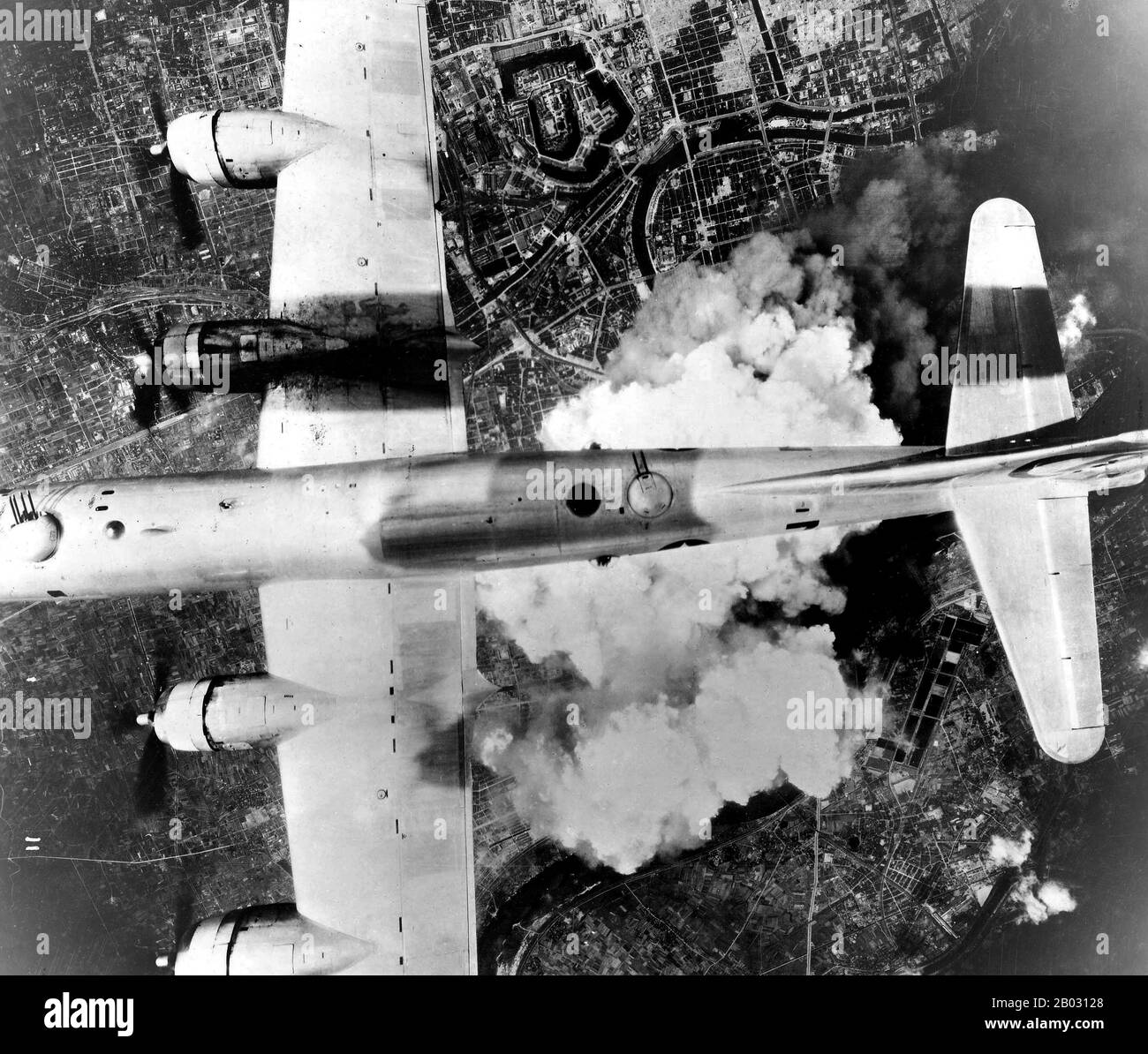 Allied forces conducted many air raids on Japan during World War II, causing extensive destruction to the country's cities and killing between 241,000 and 900,000 people. During the first years of the Pacific War, sparked by the Japanese attack on Pearl Harbor, these attacks were limited to the Doolittle Raid in April 1942 and small-scale raids on military positions in the Kuril Islands from mid-1943. Strategic bombing raids began in June 1944 and continued until the end of the war in August 1945. Allied naval and land-based tactical air units also attacked Japan during 1945. Stock Photohttps://www.alamy.com/image-license-details/?v=1https://www.alamy.com/allied-forces-conducted-many-air-raids-on-japan-during-world-war-ii-causing-extensive-destruction-to-the-countrys-cities-and-killing-between-241000-and-900000-people-during-the-first-years-of-the-pacific-war-sparked-by-the-japanese-attack-on-pearl-harbor-these-attacks-were-limited-to-the-doolittle-raid-in-april-1942-and-small-scale-raids-on-military-positions-in-the-kuril-islands-from-mid-1943-strategic-bombing-raids-began-in-june-1944-and-continued-until-the-end-of-the-war-in-august-1945-allied-naval-and-land-based-tactical-air-units-also-attacked-japan-during-1945-image344274064.html
Allied forces conducted many air raids on Japan during World War II, causing extensive destruction to the country's cities and killing between 241,000 and 900,000 people. During the first years of the Pacific War, sparked by the Japanese attack on Pearl Harbor, these attacks were limited to the Doolittle Raid in April 1942 and small-scale raids on military positions in the Kuril Islands from mid-1943. Strategic bombing raids began in June 1944 and continued until the end of the war in August 1945. Allied naval and land-based tactical air units also attacked Japan during 1945. Stock Photohttps://www.alamy.com/image-license-details/?v=1https://www.alamy.com/allied-forces-conducted-many-air-raids-on-japan-during-world-war-ii-causing-extensive-destruction-to-the-countrys-cities-and-killing-between-241000-and-900000-people-during-the-first-years-of-the-pacific-war-sparked-by-the-japanese-attack-on-pearl-harbor-these-attacks-were-limited-to-the-doolittle-raid-in-april-1942-and-small-scale-raids-on-military-positions-in-the-kuril-islands-from-mid-1943-strategic-bombing-raids-began-in-june-1944-and-continued-until-the-end-of-the-war-in-august-1945-allied-naval-and-land-based-tactical-air-units-also-attacked-japan-during-1945-image344274064.htmlRM2B03128–Allied forces conducted many air raids on Japan during World War II, causing extensive destruction to the country's cities and killing between 241,000 and 900,000 people. During the first years of the Pacific War, sparked by the Japanese attack on Pearl Harbor, these attacks were limited to the Doolittle Raid in April 1942 and small-scale raids on military positions in the Kuril Islands from mid-1943. Strategic bombing raids began in June 1944 and continued until the end of the war in August 1945. Allied naval and land-based tactical air units also attacked Japan during 1945.
 FIFTH ARMY : ITALIAN PARTISANS - 'Pippo' the Partisan Commander, pointing out enemy positions to Captain Verghis. Strategic Service Office. Photographic negative , British Army Stock Photohttps://www.alamy.com/image-license-details/?v=1https://www.alamy.com/fifth-army-italian-partisans-pippo-the-partisan-commander-pointing-out-enemy-positions-to-captain-verghis-strategic-service-office-photographic-negative-british-army-image602841214.html
FIFTH ARMY : ITALIAN PARTISANS - 'Pippo' the Partisan Commander, pointing out enemy positions to Captain Verghis. Strategic Service Office. Photographic negative , British Army Stock Photohttps://www.alamy.com/image-license-details/?v=1https://www.alamy.com/fifth-army-italian-partisans-pippo-the-partisan-commander-pointing-out-enemy-positions-to-captain-verghis-strategic-service-office-photographic-negative-british-army-image602841214.htmlRM2X0NP3A–FIFTH ARMY : ITALIAN PARTISANS - 'Pippo' the Partisan Commander, pointing out enemy positions to Captain Verghis. Strategic Service Office. Photographic negative , British Army
 Marine Dead On Iwo Jima -- Wrapped in their camouflaged ponchos on the volcanic sands of Iwo Jima, these gallant Marines have given their lives in the bloody struggle for the strategic island on the road to Tokyo, Helmets, fuel cans, packing boxes and wire clutter the beach near the silent little group. Their heavy field boots protrude from the covering which their buddies have placed over them* In the background, amtracks and tanks rumble toward enemy positions as the fight goes on. March 23, 1 Stock Photohttps://www.alamy.com/image-license-details/?v=1https://www.alamy.com/marine-dead-on-iwo-jima-wrapped-in-their-camouflaged-ponchos-on-the-volcanic-sands-of-iwo-jima-these-gallant-marines-have-given-their-lives-in-the-bloody-struggle-for-the-strategic-island-on-the-road-to-tokyo-helmets-fuel-cans-packing-boxes-and-wire-clutter-the-beach-near-the-silent-little-group-their-heavy-field-boots-protrude-from-the-covering-which-their-buddies-have-placed-over-them-in-the-background-amtracks-and-tanks-rumble-toward-enemy-positions-as-the-fight-goes-on-march-23-1-image463587668.html
Marine Dead On Iwo Jima -- Wrapped in their camouflaged ponchos on the volcanic sands of Iwo Jima, these gallant Marines have given their lives in the bloody struggle for the strategic island on the road to Tokyo, Helmets, fuel cans, packing boxes and wire clutter the beach near the silent little group. Their heavy field boots protrude from the covering which their buddies have placed over them* In the background, amtracks and tanks rumble toward enemy positions as the fight goes on. March 23, 1 Stock Photohttps://www.alamy.com/image-license-details/?v=1https://www.alamy.com/marine-dead-on-iwo-jima-wrapped-in-their-camouflaged-ponchos-on-the-volcanic-sands-of-iwo-jima-these-gallant-marines-have-given-their-lives-in-the-bloody-struggle-for-the-strategic-island-on-the-road-to-tokyo-helmets-fuel-cans-packing-boxes-and-wire-clutter-the-beach-near-the-silent-little-group-their-heavy-field-boots-protrude-from-the-covering-which-their-buddies-have-placed-over-them-in-the-background-amtracks-and-tanks-rumble-toward-enemy-positions-as-the-fight-goes-on-march-23-1-image463587668.htmlRM2HX66PC–Marine Dead On Iwo Jima -- Wrapped in their camouflaged ponchos on the volcanic sands of Iwo Jima, these gallant Marines have given their lives in the bloody struggle for the strategic island on the road to Tokyo, Helmets, fuel cans, packing boxes and wire clutter the beach near the silent little group. Their heavy field boots protrude from the covering which their buddies have placed over them* In the background, amtracks and tanks rumble toward enemy positions as the fight goes on. March 23, 1
 Black and white photo of two chess pieces standing on the chessboard. Stock Photohttps://www.alamy.com/image-license-details/?v=1https://www.alamy.com/black-and-white-photo-of-two-chess-pieces-standing-on-the-chessboard-image426540058.html
Black and white photo of two chess pieces standing on the chessboard. Stock Photohttps://www.alamy.com/image-license-details/?v=1https://www.alamy.com/black-and-white-photo-of-two-chess-pieces-standing-on-the-chessboard-image426540058.htmlRF2FNXG5E–Black and white photo of two chess pieces standing on the chessboard.
 Invasion of Ramree Island. Six of the R.A.F. Liberator who helped to blast out the Japanese positions are seen leaving the island of Ramree after making their attack. Tow clouds of smoke can be seen on the island. In support of the third large scale air, land, and sea assault or the west coast of Burma, R.A.F. Thunderbolts. Spitfires, Beaufighters, and U.S.A.A.F. P-38's of the R.A.F. Arakan Group and Liberators of Strategic Air Force, many of which were flown by Australians, and U.S.A.A.F. B-24' Stock Photohttps://www.alamy.com/image-license-details/?v=1https://www.alamy.com/invasion-of-ramree-island-six-of-the-raf-liberator-who-helped-to-blast-out-the-japanese-positions-are-seen-leaving-the-island-of-ramree-after-making-their-attack-tow-clouds-of-smoke-can-be-seen-on-the-island-in-support-of-the-third-large-scale-air-land-and-sea-assault-or-the-west-coast-of-burma-raf-thunderbolts-spitfires-beaufighters-and-usaaf-p-38s-of-the-raf-arakan-group-and-liberators-of-strategic-air-force-many-of-which-were-flown-by-australians-and-usaaf-b-24-image463584901.html
Invasion of Ramree Island. Six of the R.A.F. Liberator who helped to blast out the Japanese positions are seen leaving the island of Ramree after making their attack. Tow clouds of smoke can be seen on the island. In support of the third large scale air, land, and sea assault or the west coast of Burma, R.A.F. Thunderbolts. Spitfires, Beaufighters, and U.S.A.A.F. P-38's of the R.A.F. Arakan Group and Liberators of Strategic Air Force, many of which were flown by Australians, and U.S.A.A.F. B-24' Stock Photohttps://www.alamy.com/image-license-details/?v=1https://www.alamy.com/invasion-of-ramree-island-six-of-the-raf-liberator-who-helped-to-blast-out-the-japanese-positions-are-seen-leaving-the-island-of-ramree-after-making-their-attack-tow-clouds-of-smoke-can-be-seen-on-the-island-in-support-of-the-third-large-scale-air-land-and-sea-assault-or-the-west-coast-of-burma-raf-thunderbolts-spitfires-beaufighters-and-usaaf-p-38s-of-the-raf-arakan-group-and-liberators-of-strategic-air-force-many-of-which-were-flown-by-australians-and-usaaf-b-24-image463584901.htmlRM2HX637H–Invasion of Ramree Island. Six of the R.A.F. Liberator who helped to blast out the Japanese positions are seen leaving the island of Ramree after making their attack. Tow clouds of smoke can be seen on the island. In support of the third large scale air, land, and sea assault or the west coast of Burma, R.A.F. Thunderbolts. Spitfires, Beaufighters, and U.S.A.A.F. P-38's of the R.A.F. Arakan Group and Liberators of Strategic Air Force, many of which were flown by Australians, and U.S.A.A.F. B-24'
 . Bulletin (Pennsylvania Department of Forests and Waters), no. 40-45. Forests and forestry. 16 Posters warning: against tires should be put on the bulletin board, in the dining room and lobby and also through the forest. Precautions should be taken that no forest fires result from the refuse burner or from chimneys, by providing proper screening, careful watching, and safety zones. Supplies of forest fire fighting tools should be established in strategic positions known to the men. The list of tools should include Rich forest fire fighting tools, shovels, torches, lanterns, brooms, spray tank Stock Photohttps://www.alamy.com/image-license-details/?v=1https://www.alamy.com/bulletin-pennsylvania-department-of-forests-and-waters-no-40-45-forests-and-forestry-16-posters-warning-against-tires-should-be-put-on-the-bulletin-board-in-the-dining-room-and-lobby-and-also-through-the-forest-precautions-should-be-taken-that-no-forest-fires-result-from-the-refuse-burner-or-from-chimneys-by-providing-proper-screening-careful-watching-and-safety-zones-supplies-of-forest-fire-fighting-tools-should-be-established-in-strategic-positions-known-to-the-men-the-list-of-tools-should-include-rich-forest-fire-fighting-tools-shovels-torches-lanterns-brooms-spray-tank-image233792453.html
. Bulletin (Pennsylvania Department of Forests and Waters), no. 40-45. Forests and forestry. 16 Posters warning: against tires should be put on the bulletin board, in the dining room and lobby and also through the forest. Precautions should be taken that no forest fires result from the refuse burner or from chimneys, by providing proper screening, careful watching, and safety zones. Supplies of forest fire fighting tools should be established in strategic positions known to the men. The list of tools should include Rich forest fire fighting tools, shovels, torches, lanterns, brooms, spray tank Stock Photohttps://www.alamy.com/image-license-details/?v=1https://www.alamy.com/bulletin-pennsylvania-department-of-forests-and-waters-no-40-45-forests-and-forestry-16-posters-warning-against-tires-should-be-put-on-the-bulletin-board-in-the-dining-room-and-lobby-and-also-through-the-forest-precautions-should-be-taken-that-no-forest-fires-result-from-the-refuse-burner-or-from-chimneys-by-providing-proper-screening-careful-watching-and-safety-zones-supplies-of-forest-fire-fighting-tools-should-be-established-in-strategic-positions-known-to-the-men-the-list-of-tools-should-include-rich-forest-fire-fighting-tools-shovels-torches-lanterns-brooms-spray-tank-image233792453.htmlRMRGA4JD–. Bulletin (Pennsylvania Department of Forests and Waters), no. 40-45. Forests and forestry. 16 Posters warning: against tires should be put on the bulletin board, in the dining room and lobby and also through the forest. Precautions should be taken that no forest fires result from the refuse burner or from chimneys, by providing proper screening, careful watching, and safety zones. Supplies of forest fire fighting tools should be established in strategic positions known to the men. The list of tools should include Rich forest fire fighting tools, shovels, torches, lanterns, brooms, spray tank
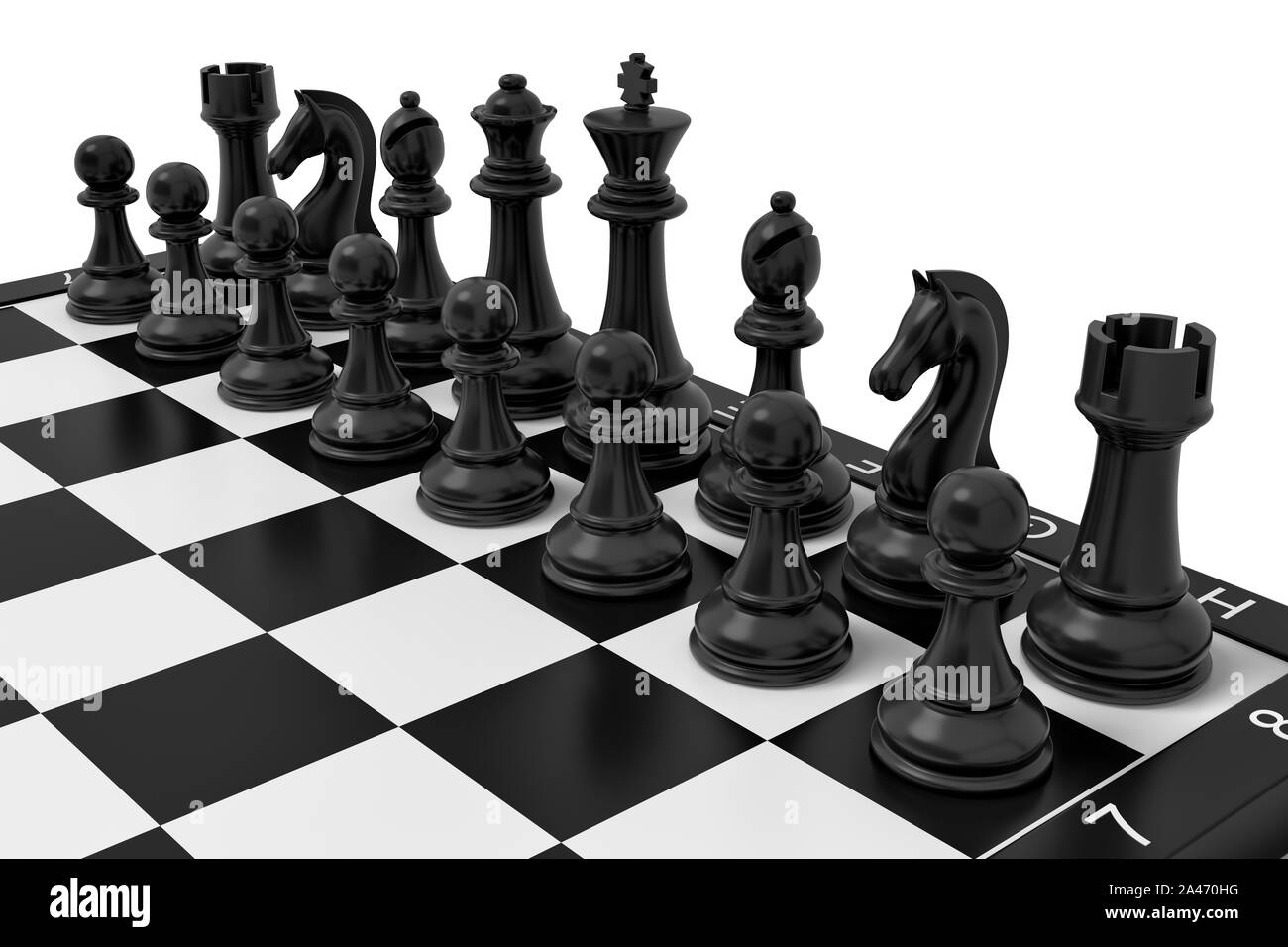 3d rendering of a full set of the black chess units standing in their starting positions. Board games. Leisure pursuits. Intellectual pastime. Stock Photohttps://www.alamy.com/image-license-details/?v=1https://www.alamy.com/3d-rendering-of-a-full-set-of-the-black-chess-units-standing-in-their-starting-positions-board-games-leisure-pursuits-intellectual-pastime-image329609772.html
3d rendering of a full set of the black chess units standing in their starting positions. Board games. Leisure pursuits. Intellectual pastime. Stock Photohttps://www.alamy.com/image-license-details/?v=1https://www.alamy.com/3d-rendering-of-a-full-set-of-the-black-chess-units-standing-in-their-starting-positions-board-games-leisure-pursuits-intellectual-pastime-image329609772.htmlRF2A470HG–3d rendering of a full set of the black chess units standing in their starting positions. Board games. Leisure pursuits. Intellectual pastime.
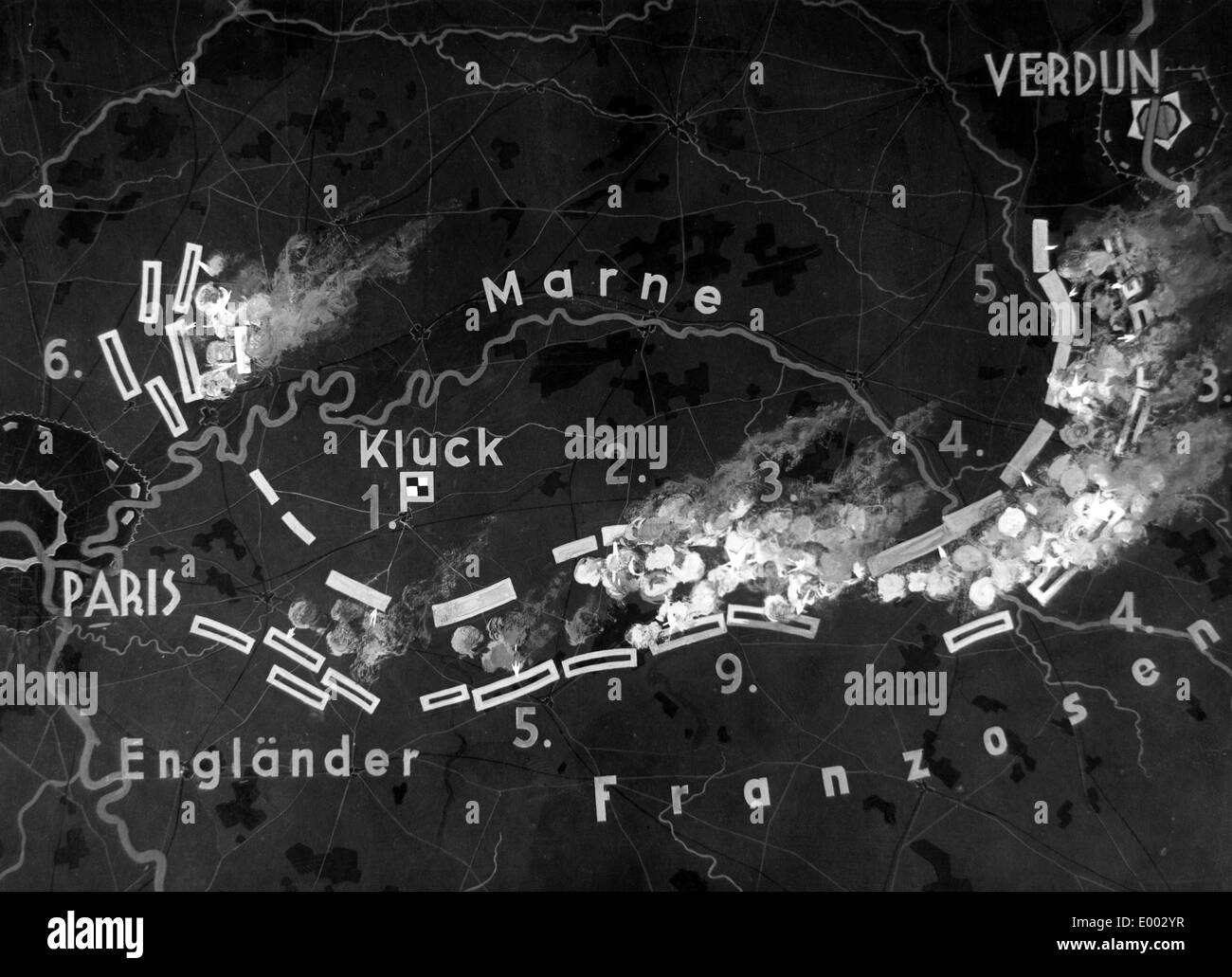 Map of the First Battle of the Marne, 1914 Stock Photohttps://www.alamy.com/image-license-details/?v=1https://www.alamy.com/map-of-the-first-battle-of-the-marne-1914-image68843819.html
Map of the First Battle of the Marne, 1914 Stock Photohttps://www.alamy.com/image-license-details/?v=1https://www.alamy.com/map-of-the-first-battle-of-the-marne-1914-image68843819.htmlRME002YR–Map of the First Battle of the Marne, 1914
 German armored turret of the 19th century with a rotating ring mount to turn the gun to any direction with the gunner directly behind it, the weapon held in an intermediate elevation by an hoist machine Stock Photohttps://www.alamy.com/image-license-details/?v=1https://www.alamy.com/german-armored-turret-of-the-19th-century-with-a-rotating-ring-mount-to-turn-the-gun-to-any-direction-with-the-gunner-directly-behind-it-the-weapon-held-in-an-intermediate-elevation-by-an-hoist-machine-image331317457.html
German armored turret of the 19th century with a rotating ring mount to turn the gun to any direction with the gunner directly behind it, the weapon held in an intermediate elevation by an hoist machine Stock Photohttps://www.alamy.com/image-license-details/?v=1https://www.alamy.com/german-armored-turret-of-the-19th-century-with-a-rotating-ring-mount-to-turn-the-gun-to-any-direction-with-the-gunner-directly-behind-it-the-weapon-held-in-an-intermediate-elevation-by-an-hoist-machine-image331317457.htmlRF2A70PP9–German armored turret of the 19th century with a rotating ring mount to turn the gun to any direction with the gunner directly behind it, the weapon held in an intermediate elevation by an hoist machine
 Colonel L. E. Wilson, Lt. Colonel F. B. Wood, and Major General Lewis J. Fields discuss the layout of 1st Battalion, 7th Marine Regiment and the strategic positions acquired during Operation Mobile. The meeting took place on Hill #40 at the end of the operation. This photograph was taken by Pfc. Norman on May 28, 1966. It is a Defense Department photo (Marine Corps) with the code A369315. Stock Photohttps://www.alamy.com/image-license-details/?v=1https://www.alamy.com/colonel-l-e-wilson-lt-colonel-f-b-wood-and-major-general-lewis-j-fields-discuss-the-layout-of-1st-battalion-7th-marine-regiment-and-the-strategic-positions-acquired-during-operation-mobile-the-meeting-took-place-on-hill-40-at-the-end-of-the-operation-this-photograph-was-taken-by-pfc-norman-on-may-28-1966-it-is-a-defense-department-photo-marine-corps-with-the-code-a369315-image574147671.html
Colonel L. E. Wilson, Lt. Colonel F. B. Wood, and Major General Lewis J. Fields discuss the layout of 1st Battalion, 7th Marine Regiment and the strategic positions acquired during Operation Mobile. The meeting took place on Hill #40 at the end of the operation. This photograph was taken by Pfc. Norman on May 28, 1966. It is a Defense Department photo (Marine Corps) with the code A369315. Stock Photohttps://www.alamy.com/image-license-details/?v=1https://www.alamy.com/colonel-l-e-wilson-lt-colonel-f-b-wood-and-major-general-lewis-j-fields-discuss-the-layout-of-1st-battalion-7th-marine-regiment-and-the-strategic-positions-acquired-during-operation-mobile-the-meeting-took-place-on-hill-40-at-the-end-of-the-operation-this-photograph-was-taken-by-pfc-norman-on-may-28-1966-it-is-a-defense-department-photo-marine-corps-with-the-code-a369315-image574147671.htmlRM2TA2K5Y–Colonel L. E. Wilson, Lt. Colonel F. B. Wood, and Major General Lewis J. Fields discuss the layout of 1st Battalion, 7th Marine Regiment and the strategic positions acquired during Operation Mobile. The meeting took place on Hill #40 at the end of the operation. This photograph was taken by Pfc. Norman on May 28, 1966. It is a Defense Department photo (Marine Corps) with the code A369315.
 The Siege of Sebastopol - general view, 1854. Crimean War. Map showing the Russian-held ports of Sebastopol and Balaclava, harbours and warships. On the Black Sea are Allied warships, and also shown are positions of the French and English armies besieging the ports. 'A Russian deserter came over from Sebastopol, after having received a tremendous flogging for delaying to turn out on the occasion of the last alarm. He said that the Russians had moved all but seven thousand men to the other side of Sebastopol harbour'. From "Illustrated London News", 1854. Stock Photohttps://www.alamy.com/image-license-details/?v=1https://www.alamy.com/the-siege-of-sebastopol-general-view-1854-crimean-war-map-showing-the-russian-held-ports-of-sebastopol-and-balaclava-harbours-and-warships-on-the-black-sea-are-allied-warships-and-also-shown-are-positions-of-the-french-and-english-armies-besieging-the-ports-a-russian-deserter-came-over-from-sebastopol-after-having-received-a-tremendous-flogging-for-delaying-to-turn-out-on-the-occasion-of-the-last-alarm-he-said-that-the-russians-had-moved-all-but-seven-thousand-men-to-the-other-side-of-sebastopol-harbour-from-quotillustrated-london-newsquot-1854-image481978861.html
The Siege of Sebastopol - general view, 1854. Crimean War. Map showing the Russian-held ports of Sebastopol and Balaclava, harbours and warships. On the Black Sea are Allied warships, and also shown are positions of the French and English armies besieging the ports. 'A Russian deserter came over from Sebastopol, after having received a tremendous flogging for delaying to turn out on the occasion of the last alarm. He said that the Russians had moved all but seven thousand men to the other side of Sebastopol harbour'. From "Illustrated London News", 1854. Stock Photohttps://www.alamy.com/image-license-details/?v=1https://www.alamy.com/the-siege-of-sebastopol-general-view-1854-crimean-war-map-showing-the-russian-held-ports-of-sebastopol-and-balaclava-harbours-and-warships-on-the-black-sea-are-allied-warships-and-also-shown-are-positions-of-the-french-and-english-armies-besieging-the-ports-a-russian-deserter-came-over-from-sebastopol-after-having-received-a-tremendous-flogging-for-delaying-to-turn-out-on-the-occasion-of-the-last-alarm-he-said-that-the-russians-had-moved-all-but-seven-thousand-men-to-the-other-side-of-sebastopol-harbour-from-quotillustrated-london-newsquot-1854-image481978861.htmlRM2K040XN–The Siege of Sebastopol - general view, 1854. Crimean War. Map showing the Russian-held ports of Sebastopol and Balaclava, harbours and warships. On the Black Sea are Allied warships, and also shown are positions of the French and English armies besieging the ports. 'A Russian deserter came over from Sebastopol, after having received a tremendous flogging for delaying to turn out on the occasion of the last alarm. He said that the Russians had moved all but seven thousand men to the other side of Sebastopol harbour'. From "Illustrated London News", 1854.
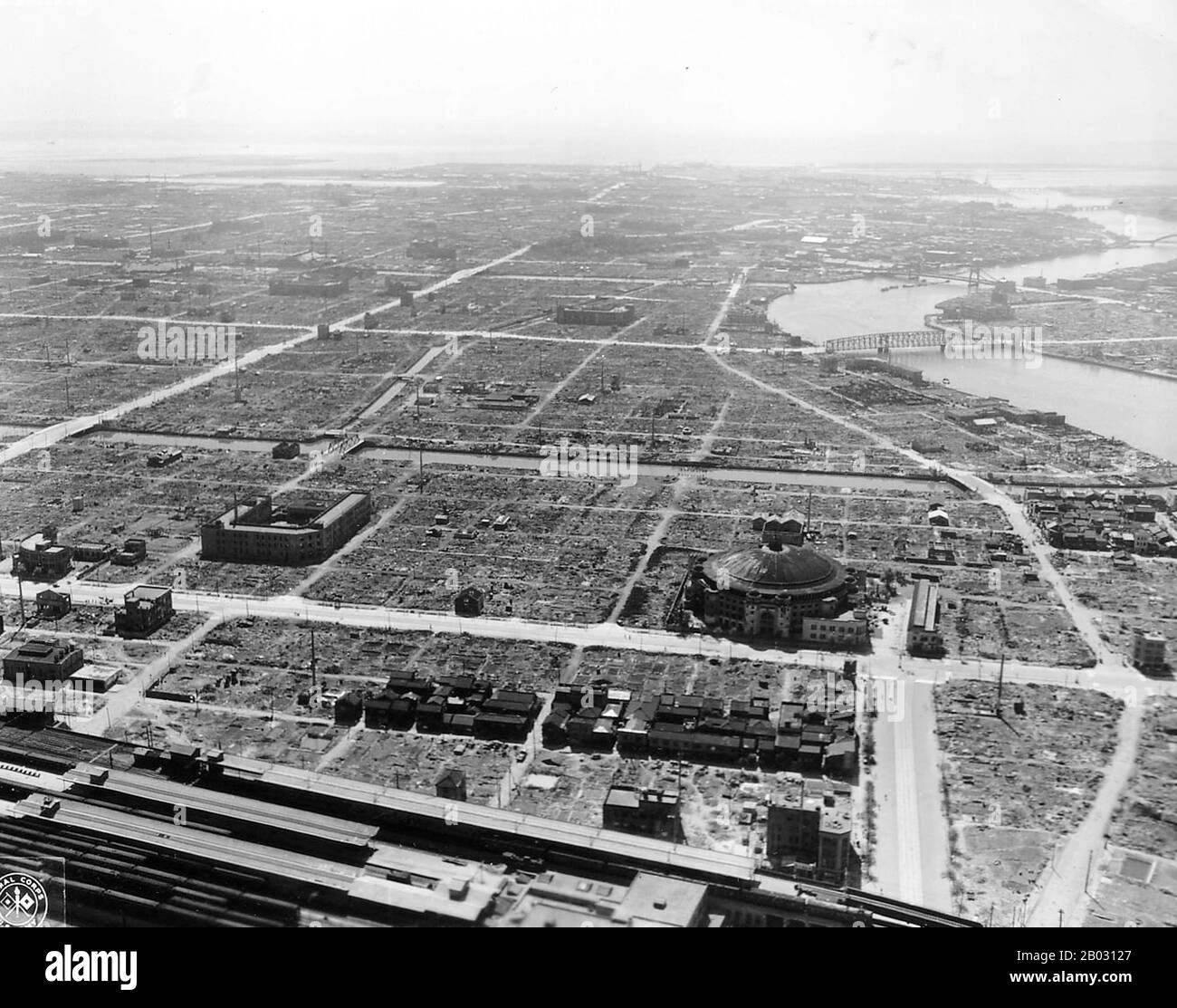 Allied forces conducted many air raids on Japan during World War II, causing extensive destruction to the country's cities and killing between 241,000 and 900,000 people. During the first years of the Pacific War, sparked by the Japanese attack on Pearl Harbor, these attacks were limited to the Doolittle Raid in April 1942 and small-scale raids on military positions in the Kuril Islands from mid-1943. Strategic bombing raids began in June 1944 and continued until the end of the war in August 1945. Allied naval and land-based tactical air units also attacked Japan during 1945. Stock Photohttps://www.alamy.com/image-license-details/?v=1https://www.alamy.com/allied-forces-conducted-many-air-raids-on-japan-during-world-war-ii-causing-extensive-destruction-to-the-countrys-cities-and-killing-between-241000-and-900000-people-during-the-first-years-of-the-pacific-war-sparked-by-the-japanese-attack-on-pearl-harbor-these-attacks-were-limited-to-the-doolittle-raid-in-april-1942-and-small-scale-raids-on-military-positions-in-the-kuril-islands-from-mid-1943-strategic-bombing-raids-began-in-june-1944-and-continued-until-the-end-of-the-war-in-august-1945-allied-naval-and-land-based-tactical-air-units-also-attacked-japan-during-1945-image344274063.html
Allied forces conducted many air raids on Japan during World War II, causing extensive destruction to the country's cities and killing between 241,000 and 900,000 people. During the first years of the Pacific War, sparked by the Japanese attack on Pearl Harbor, these attacks were limited to the Doolittle Raid in April 1942 and small-scale raids on military positions in the Kuril Islands from mid-1943. Strategic bombing raids began in June 1944 and continued until the end of the war in August 1945. Allied naval and land-based tactical air units also attacked Japan during 1945. Stock Photohttps://www.alamy.com/image-license-details/?v=1https://www.alamy.com/allied-forces-conducted-many-air-raids-on-japan-during-world-war-ii-causing-extensive-destruction-to-the-countrys-cities-and-killing-between-241000-and-900000-people-during-the-first-years-of-the-pacific-war-sparked-by-the-japanese-attack-on-pearl-harbor-these-attacks-were-limited-to-the-doolittle-raid-in-april-1942-and-small-scale-raids-on-military-positions-in-the-kuril-islands-from-mid-1943-strategic-bombing-raids-began-in-june-1944-and-continued-until-the-end-of-the-war-in-august-1945-allied-naval-and-land-based-tactical-air-units-also-attacked-japan-during-1945-image344274063.htmlRM2B03127–Allied forces conducted many air raids on Japan during World War II, causing extensive destruction to the country's cities and killing between 241,000 and 900,000 people. During the first years of the Pacific War, sparked by the Japanese attack on Pearl Harbor, these attacks were limited to the Doolittle Raid in April 1942 and small-scale raids on military positions in the Kuril Islands from mid-1943. Strategic bombing raids began in June 1944 and continued until the end of the war in August 1945. Allied naval and land-based tactical air units also attacked Japan during 1945.
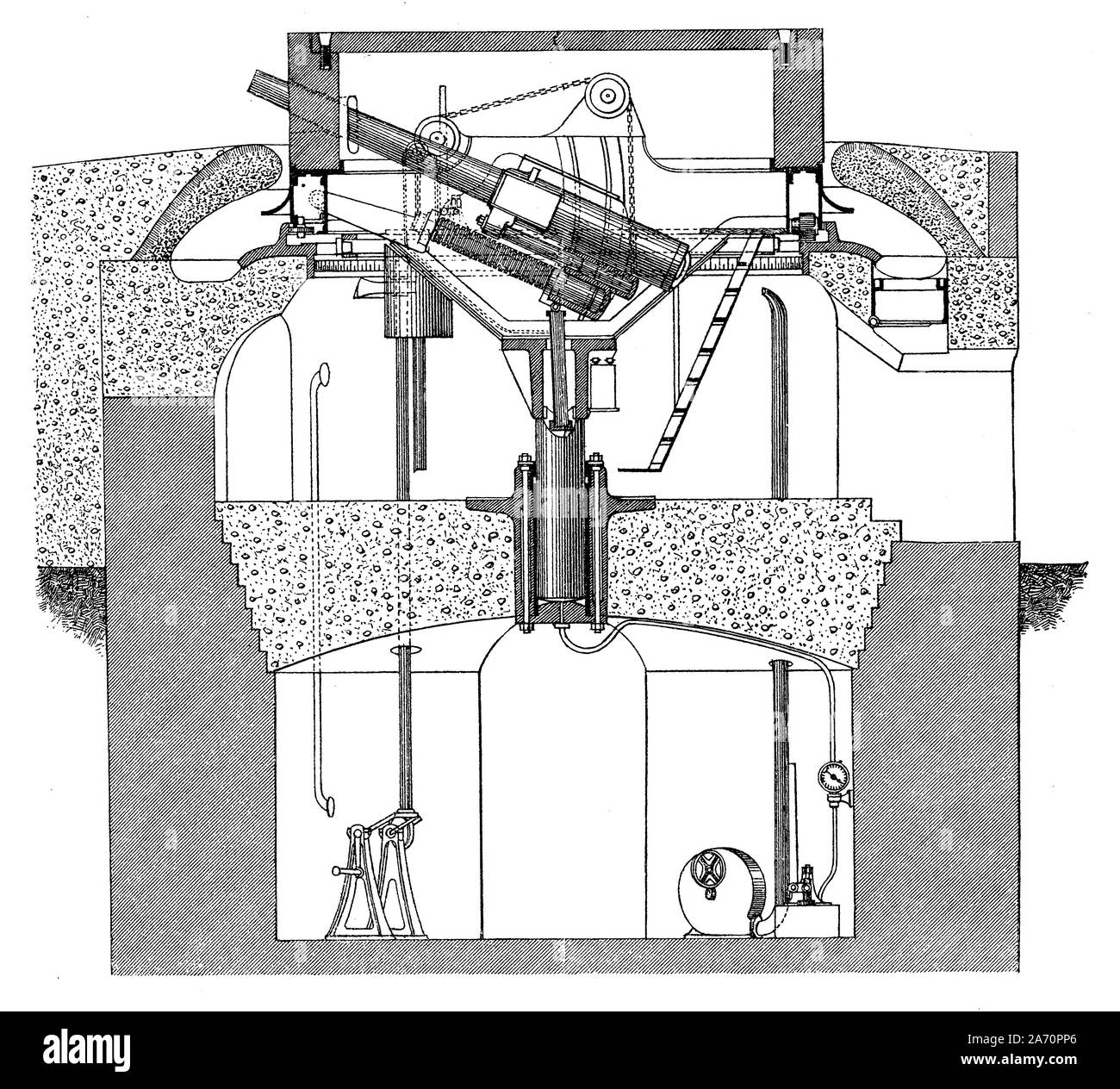 French armored turret 19th century with weapon mounted in casemate or ships to be aimed and fired with a certain degree of elevation and/ or rotation Stock Photohttps://www.alamy.com/image-license-details/?v=1https://www.alamy.com/french-armored-turret-19th-century-with-weapon-mounted-in-casemate-or-ships-to-be-aimed-and-fired-with-a-certain-degree-of-elevation-and-or-rotation-image331317454.html
French armored turret 19th century with weapon mounted in casemate or ships to be aimed and fired with a certain degree of elevation and/ or rotation Stock Photohttps://www.alamy.com/image-license-details/?v=1https://www.alamy.com/french-armored-turret-19th-century-with-weapon-mounted-in-casemate-or-ships-to-be-aimed-and-fired-with-a-certain-degree-of-elevation-and-or-rotation-image331317454.htmlRF2A70PP6–French armored turret 19th century with weapon mounted in casemate or ships to be aimed and fired with a certain degree of elevation and/ or rotation
 Continuing their attack on the enemy's strategic positions in the Naples area, Flying Fortresses of the Northwest African Air Force are here blasting the Mignano Road bridges, 35 miles northwest of Naples. Stock Photohttps://www.alamy.com/image-license-details/?v=1https://www.alamy.com/continuing-their-attack-on-the-enemys-strategic-positions-in-the-naples-area-flying-fortresses-of-the-northwest-african-air-force-are-here-blasting-the-mignano-road-bridges-35-miles-northwest-of-naples-image481128309.html
Continuing their attack on the enemy's strategic positions in the Naples area, Flying Fortresses of the Northwest African Air Force are here blasting the Mignano Road bridges, 35 miles northwest of Naples. Stock Photohttps://www.alamy.com/image-license-details/?v=1https://www.alamy.com/continuing-their-attack-on-the-enemys-strategic-positions-in-the-naples-area-flying-fortresses-of-the-northwest-african-air-force-are-here-blasting-the-mignano-road-bridges-35-miles-northwest-of-naples-image481128309.htmlRM2JXN81W–Continuing their attack on the enemy's strategic positions in the Naples area, Flying Fortresses of the Northwest African Air Force are here blasting the Mignano Road bridges, 35 miles northwest of Naples.
!['Plan of British Positions at the First Attack on Koreigaum', c1891. From "Cassell's Illustrated History of India Vol. I.", by James Grant. [Cassell Petter & Galpin, London, Paris and New York] Stock Photo 'Plan of British Positions at the First Attack on Koreigaum', c1891. From "Cassell's Illustrated History of India Vol. I.", by James Grant. [Cassell Petter & Galpin, London, Paris and New York] Stock Photo](https://c8.alamy.com/comp/2J897C1/plan-of-british-positions-at-the-first-attack-on-koreigaum-c1891-from-quotcassells-illustrated-history-of-india-vol-iquot-by-james-grant-cassell-petter-amp-galpin-london-paris-and-new-york-2J897C1.jpg) 'Plan of British Positions at the First Attack on Koreigaum', c1891. From "Cassell's Illustrated History of India Vol. I.", by James Grant. [Cassell Petter & Galpin, London, Paris and New York] Stock Photohttps://www.alamy.com/image-license-details/?v=1https://www.alamy.com/plan-of-british-positions-at-the-first-attack-on-koreigaum-c1891-from-quotcassells-illustrated-history-of-india-vol-iquot-by-james-grant-cassell-petter-amp-galpin-london-paris-and-new-york-image469800577.html
'Plan of British Positions at the First Attack on Koreigaum', c1891. From "Cassell's Illustrated History of India Vol. I.", by James Grant. [Cassell Petter & Galpin, London, Paris and New York] Stock Photohttps://www.alamy.com/image-license-details/?v=1https://www.alamy.com/plan-of-british-positions-at-the-first-attack-on-koreigaum-c1891-from-quotcassells-illustrated-history-of-india-vol-iquot-by-james-grant-cassell-petter-amp-galpin-london-paris-and-new-york-image469800577.htmlRM2J897C1–'Plan of British Positions at the First Attack on Koreigaum', c1891. From "Cassell's Illustrated History of India Vol. I.", by James Grant. [Cassell Petter & Galpin, London, Paris and New York]
 Allied forces conducted many air raids on Japan during World War II, causing extensive destruction to the country's cities and killing between 241,000 and 900,000 people. During the first years of the Pacific War, sparked by the Japanese attack on Pearl Harbor, these attacks were limited to the Doolittle Raid in April 1942 and small-scale raids on military positions in the Kuril Islands from mid-1943. Strategic bombing raids began in June 1944 and continued until the end of the war in August 1945. Allied naval and land-based tactical air units also attacked Japan during 1945. Stock Photohttps://www.alamy.com/image-license-details/?v=1https://www.alamy.com/allied-forces-conducted-many-air-raids-on-japan-during-world-war-ii-causing-extensive-destruction-to-the-countrys-cities-and-killing-between-241000-and-900000-people-during-the-first-years-of-the-pacific-war-sparked-by-the-japanese-attack-on-pearl-harbor-these-attacks-were-limited-to-the-doolittle-raid-in-april-1942-and-small-scale-raids-on-military-positions-in-the-kuril-islands-from-mid-1943-strategic-bombing-raids-began-in-june-1944-and-continued-until-the-end-of-the-war-in-august-1945-allied-naval-and-land-based-tactical-air-units-also-attacked-japan-during-1945-image344274065.html
Allied forces conducted many air raids on Japan during World War II, causing extensive destruction to the country's cities and killing between 241,000 and 900,000 people. During the first years of the Pacific War, sparked by the Japanese attack on Pearl Harbor, these attacks were limited to the Doolittle Raid in April 1942 and small-scale raids on military positions in the Kuril Islands from mid-1943. Strategic bombing raids began in June 1944 and continued until the end of the war in August 1945. Allied naval and land-based tactical air units also attacked Japan during 1945. Stock Photohttps://www.alamy.com/image-license-details/?v=1https://www.alamy.com/allied-forces-conducted-many-air-raids-on-japan-during-world-war-ii-causing-extensive-destruction-to-the-countrys-cities-and-killing-between-241000-and-900000-people-during-the-first-years-of-the-pacific-war-sparked-by-the-japanese-attack-on-pearl-harbor-these-attacks-were-limited-to-the-doolittle-raid-in-april-1942-and-small-scale-raids-on-military-positions-in-the-kuril-islands-from-mid-1943-strategic-bombing-raids-began-in-june-1944-and-continued-until-the-end-of-the-war-in-august-1945-allied-naval-and-land-based-tactical-air-units-also-attacked-japan-during-1945-image344274065.htmlRM2B03129–Allied forces conducted many air raids on Japan during World War II, causing extensive destruction to the country's cities and killing between 241,000 and 900,000 people. During the first years of the Pacific War, sparked by the Japanese attack on Pearl Harbor, these attacks were limited to the Doolittle Raid in April 1942 and small-scale raids on military positions in the Kuril Islands from mid-1943. Strategic bombing raids began in June 1944 and continued until the end of the war in August 1945. Allied naval and land-based tactical air units also attacked Japan during 1945.
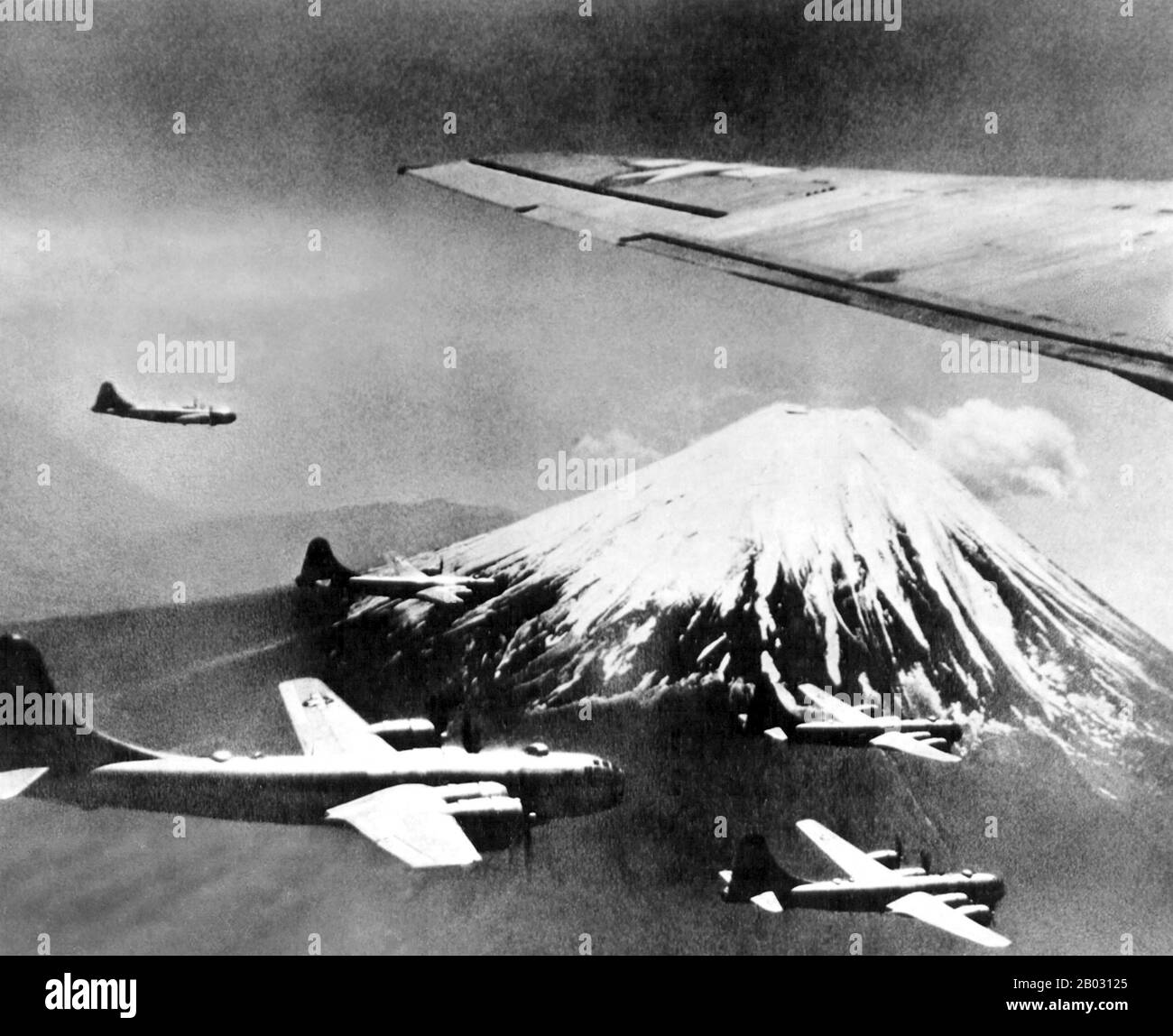 Allied forces conducted many air raids on Japan during World War II, causing extensive destruction to the country's cities and killing between 241,000 and 900,000 people. During the first years of the Pacific War, sparked by the Japanese attack on Pearl Harbor, these attacks were limited to the Doolittle Raid in April 1942 and small-scale raids on military positions in the Kuril Islands from mid-1943. Strategic bombing raids began in June 1944 and continued until the end of the war in August 1945. Allied naval and land-based tactical air units also attacked Japan during 1945. Stock Photohttps://www.alamy.com/image-license-details/?v=1https://www.alamy.com/allied-forces-conducted-many-air-raids-on-japan-during-world-war-ii-causing-extensive-destruction-to-the-countrys-cities-and-killing-between-241000-and-900000-people-during-the-first-years-of-the-pacific-war-sparked-by-the-japanese-attack-on-pearl-harbor-these-attacks-were-limited-to-the-doolittle-raid-in-april-1942-and-small-scale-raids-on-military-positions-in-the-kuril-islands-from-mid-1943-strategic-bombing-raids-began-in-june-1944-and-continued-until-the-end-of-the-war-in-august-1945-allied-naval-and-land-based-tactical-air-units-also-attacked-japan-during-1945-image344274061.html
Allied forces conducted many air raids on Japan during World War II, causing extensive destruction to the country's cities and killing between 241,000 and 900,000 people. During the first years of the Pacific War, sparked by the Japanese attack on Pearl Harbor, these attacks were limited to the Doolittle Raid in April 1942 and small-scale raids on military positions in the Kuril Islands from mid-1943. Strategic bombing raids began in June 1944 and continued until the end of the war in August 1945. Allied naval and land-based tactical air units also attacked Japan during 1945. Stock Photohttps://www.alamy.com/image-license-details/?v=1https://www.alamy.com/allied-forces-conducted-many-air-raids-on-japan-during-world-war-ii-causing-extensive-destruction-to-the-countrys-cities-and-killing-between-241000-and-900000-people-during-the-first-years-of-the-pacific-war-sparked-by-the-japanese-attack-on-pearl-harbor-these-attacks-were-limited-to-the-doolittle-raid-in-april-1942-and-small-scale-raids-on-military-positions-in-the-kuril-islands-from-mid-1943-strategic-bombing-raids-began-in-june-1944-and-continued-until-the-end-of-the-war-in-august-1945-allied-naval-and-land-based-tactical-air-units-also-attacked-japan-during-1945-image344274061.htmlRM2B03125–Allied forces conducted many air raids on Japan during World War II, causing extensive destruction to the country's cities and killing between 241,000 and 900,000 people. During the first years of the Pacific War, sparked by the Japanese attack on Pearl Harbor, these attacks were limited to the Doolittle Raid in April 1942 and small-scale raids on military positions in the Kuril Islands from mid-1943. Strategic bombing raids began in June 1944 and continued until the end of the war in August 1945. Allied naval and land-based tactical air units also attacked Japan during 1945.
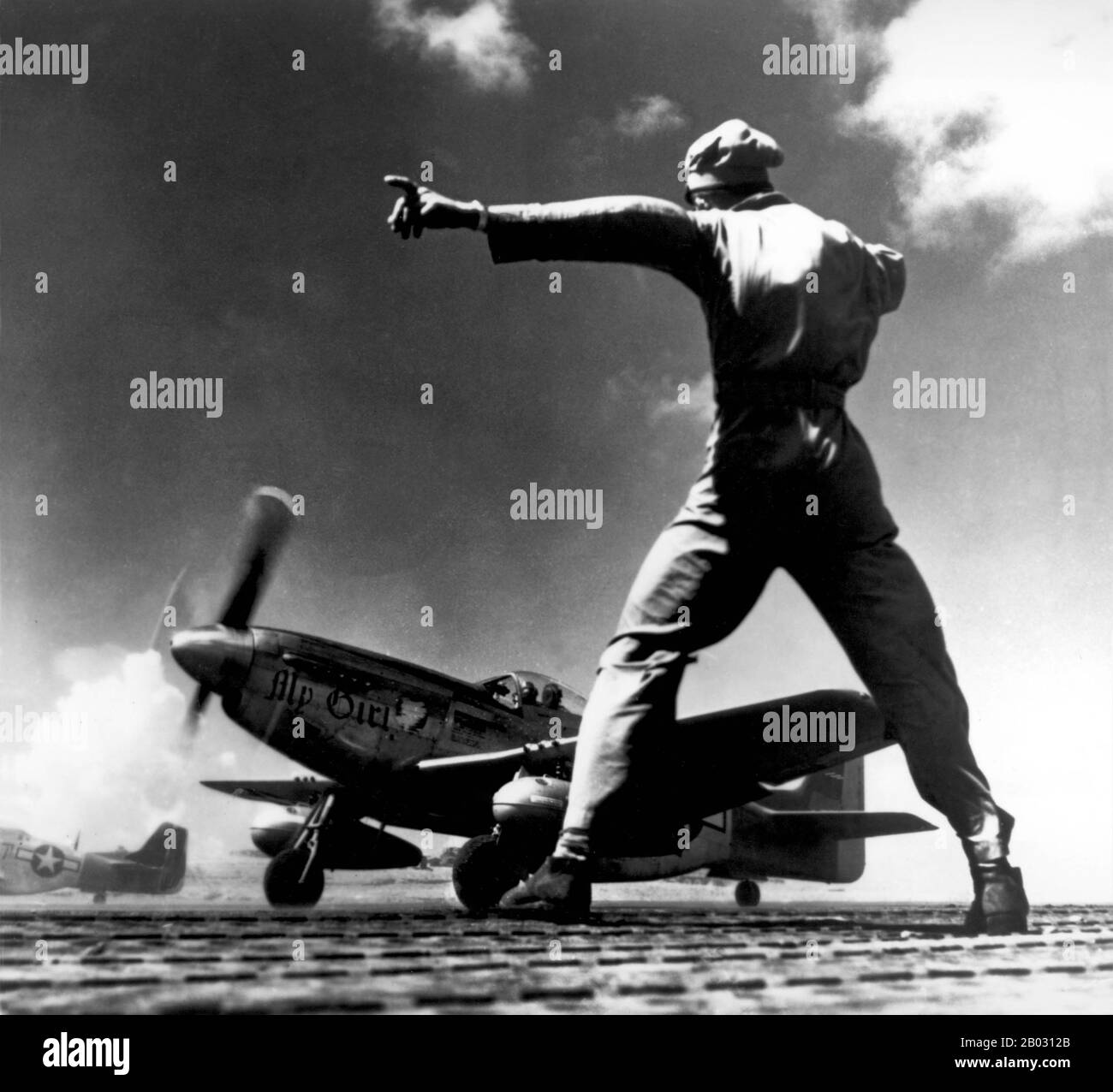 Allied forces conducted many air raids on Japan during World War II, causing extensive destruction to the country's cities and killing between 241,000 and 900,000 people. During the first years of the Pacific War, sparked by the Japanese attack on Pearl Harbor, these attacks were limited to the Doolittle Raid in April 1942 and small-scale raids on military positions in the Kuril Islands from mid-1943. Strategic bombing raids began in June 1944 and continued until the end of the war in August 1945. Allied naval and land-based tactical air units also attacked Japan during 1945. Stock Photohttps://www.alamy.com/image-license-details/?v=1https://www.alamy.com/allied-forces-conducted-many-air-raids-on-japan-during-world-war-ii-causing-extensive-destruction-to-the-countrys-cities-and-killing-between-241000-and-900000-people-during-the-first-years-of-the-pacific-war-sparked-by-the-japanese-attack-on-pearl-harbor-these-attacks-were-limited-to-the-doolittle-raid-in-april-1942-and-small-scale-raids-on-military-positions-in-the-kuril-islands-from-mid-1943-strategic-bombing-raids-began-in-june-1944-and-continued-until-the-end-of-the-war-in-august-1945-allied-naval-and-land-based-tactical-air-units-also-attacked-japan-during-1945-image344274067.html
Allied forces conducted many air raids on Japan during World War II, causing extensive destruction to the country's cities and killing between 241,000 and 900,000 people. During the first years of the Pacific War, sparked by the Japanese attack on Pearl Harbor, these attacks were limited to the Doolittle Raid in April 1942 and small-scale raids on military positions in the Kuril Islands from mid-1943. Strategic bombing raids began in June 1944 and continued until the end of the war in August 1945. Allied naval and land-based tactical air units also attacked Japan during 1945. Stock Photohttps://www.alamy.com/image-license-details/?v=1https://www.alamy.com/allied-forces-conducted-many-air-raids-on-japan-during-world-war-ii-causing-extensive-destruction-to-the-countrys-cities-and-killing-between-241000-and-900000-people-during-the-first-years-of-the-pacific-war-sparked-by-the-japanese-attack-on-pearl-harbor-these-attacks-were-limited-to-the-doolittle-raid-in-april-1942-and-small-scale-raids-on-military-positions-in-the-kuril-islands-from-mid-1943-strategic-bombing-raids-began-in-june-1944-and-continued-until-the-end-of-the-war-in-august-1945-allied-naval-and-land-based-tactical-air-units-also-attacked-japan-during-1945-image344274067.htmlRM2B0312B–Allied forces conducted many air raids on Japan during World War II, causing extensive destruction to the country's cities and killing between 241,000 and 900,000 people. During the first years of the Pacific War, sparked by the Japanese attack on Pearl Harbor, these attacks were limited to the Doolittle Raid in April 1942 and small-scale raids on military positions in the Kuril Islands from mid-1943. Strategic bombing raids began in June 1944 and continued until the end of the war in August 1945. Allied naval and land-based tactical air units also attacked Japan during 1945.
 TOP: Balikpapan's enemy fuel output, a maze of warehouses, oil storage tanks and cracking installations, is shown here 8 March 1945. On that day 'Jungle Air Force' began its all out strategic bombing of Japanese defensive positions. BOTTOM: Only Stock Photohttps://www.alamy.com/image-license-details/?v=1https://www.alamy.com/top-balikpapans-enemy-fuel-output-a-maze-of-warehouses-oil-storage-tanks-and-cracking-installations-is-shown-here-8-march-1945-on-that-day-jungle-air-force-began-its-all-out-strategic-bombing-of-japanese-defensive-positions-bottom-only-image481067337.html
TOP: Balikpapan's enemy fuel output, a maze of warehouses, oil storage tanks and cracking installations, is shown here 8 March 1945. On that day 'Jungle Air Force' began its all out strategic bombing of Japanese defensive positions. BOTTOM: Only Stock Photohttps://www.alamy.com/image-license-details/?v=1https://www.alamy.com/top-balikpapans-enemy-fuel-output-a-maze-of-warehouses-oil-storage-tanks-and-cracking-installations-is-shown-here-8-march-1945-on-that-day-jungle-air-force-began-its-all-out-strategic-bombing-of-japanese-defensive-positions-bottom-only-image481067337.htmlRM2JXJE89–TOP: Balikpapan's enemy fuel output, a maze of warehouses, oil storage tanks and cracking installations, is shown here 8 March 1945. On that day 'Jungle Air Force' began its all out strategic bombing of Japanese defensive positions. BOTTOM: Only
 The Official Arrangement of the British Division off the coast of the Crimea, 1854. Crimean War: plan of attack. Diagram showing the positions of Royal Navy ships carrying troops of the Light Division, 1st, 2nd, 3rd and 4th Divisions, and Cavalry. The key indicates steam-tugs, steamers, men-of-war, infantry, artillery and reserve ammunition. 'When the troops are in the boats they will form on the off-shore side of the ships from which they disembark, ready to form the line abreast, on the signal being made from the Agamemnon...All officers of boats will distinctly understand, that they are to Stock Photohttps://www.alamy.com/image-license-details/?v=1https://www.alamy.com/the-official-arrangement-of-the-british-division-off-the-coast-of-the-crimea-1854-crimean-war-plan-of-attack-diagram-showing-the-positions-of-royal-navy-ships-carrying-troops-of-the-light-division-1st-2nd-3rd-and-4th-divisions-and-cavalry-the-key-indicates-steam-tugs-steamers-men-of-war-infantry-artillery-and-reserve-ammunition-when-the-troops-are-in-the-boats-they-will-form-on-the-off-shore-side-of-the-ships-from-which-they-disembark-ready-to-form-the-line-abreast-on-the-signal-being-made-from-the-agamemnonall-officers-of-boats-will-distinctly-understand-that-they-are-to-image481978083.html
The Official Arrangement of the British Division off the coast of the Crimea, 1854. Crimean War: plan of attack. Diagram showing the positions of Royal Navy ships carrying troops of the Light Division, 1st, 2nd, 3rd and 4th Divisions, and Cavalry. The key indicates steam-tugs, steamers, men-of-war, infantry, artillery and reserve ammunition. 'When the troops are in the boats they will form on the off-shore side of the ships from which they disembark, ready to form the line abreast, on the signal being made from the Agamemnon...All officers of boats will distinctly understand, that they are to Stock Photohttps://www.alamy.com/image-license-details/?v=1https://www.alamy.com/the-official-arrangement-of-the-british-division-off-the-coast-of-the-crimea-1854-crimean-war-plan-of-attack-diagram-showing-the-positions-of-royal-navy-ships-carrying-troops-of-the-light-division-1st-2nd-3rd-and-4th-divisions-and-cavalry-the-key-indicates-steam-tugs-steamers-men-of-war-infantry-artillery-and-reserve-ammunition-when-the-troops-are-in-the-boats-they-will-form-on-the-off-shore-side-of-the-ships-from-which-they-disembark-ready-to-form-the-line-abreast-on-the-signal-being-made-from-the-agamemnonall-officers-of-boats-will-distinctly-understand-that-they-are-to-image481978083.htmlRM2K03YXY–The Official Arrangement of the British Division off the coast of the Crimea, 1854. Crimean War: plan of attack. Diagram showing the positions of Royal Navy ships carrying troops of the Light Division, 1st, 2nd, 3rd and 4th Divisions, and Cavalry. The key indicates steam-tugs, steamers, men-of-war, infantry, artillery and reserve ammunition. 'When the troops are in the boats they will form on the off-shore side of the ships from which they disembark, ready to form the line abreast, on the signal being made from the Agamemnon...All officers of boats will distinctly understand, that they are to
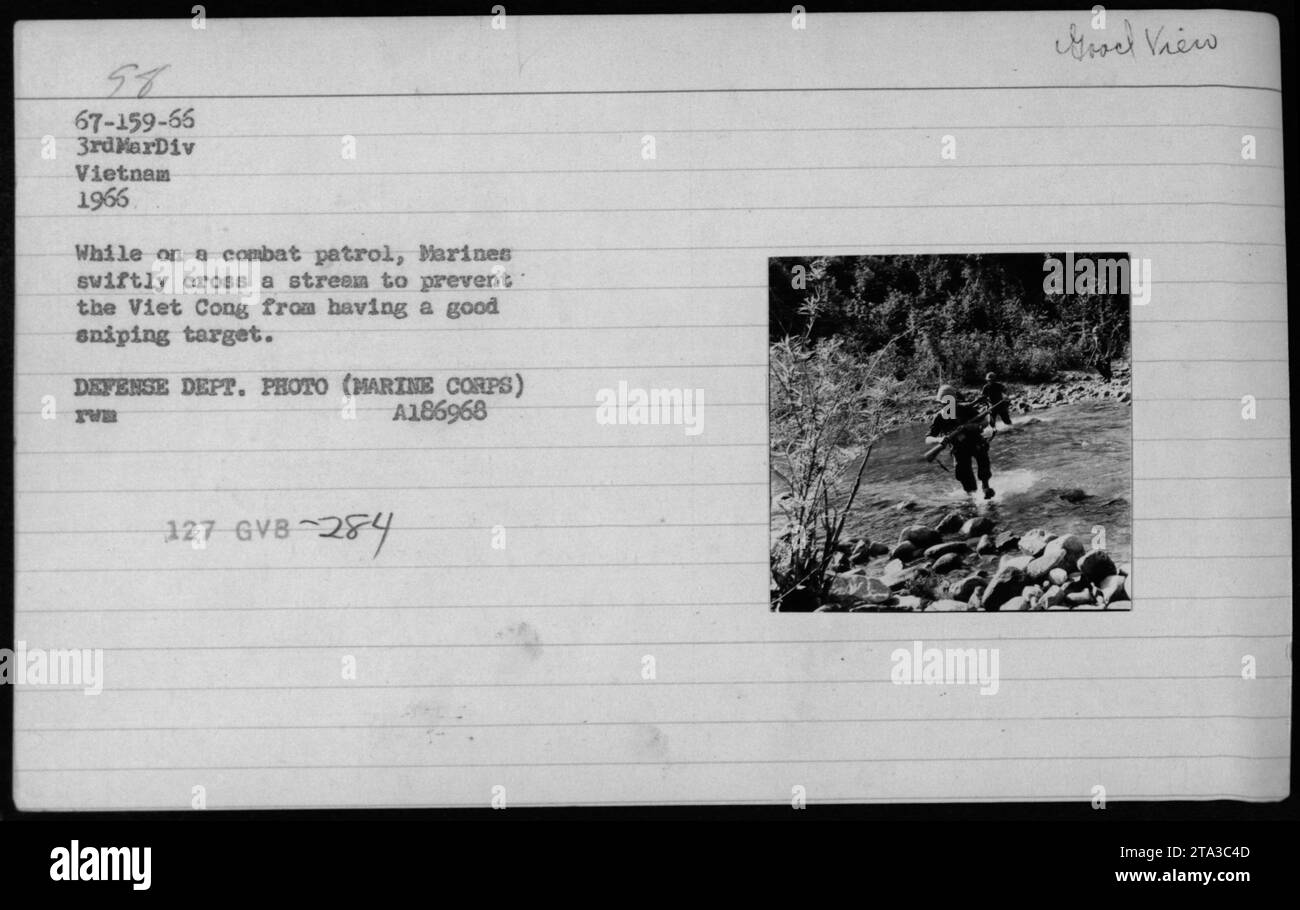 Marines from the 3rd Marine Division swiftly cross a stream during a combat patrol in Vietnam in 1966. Their purpose is to eliminate potential sniping positions for the Viet Cong. This Defense Department photograph (Marine Corps) with the identification code A186968 captures a moment of strategic movement and vigilance in the Vietnam War. Stock Photohttps://www.alamy.com/image-license-details/?v=1https://www.alamy.com/marines-from-the-3rd-marine-division-swiftly-cross-a-stream-during-a-combat-patrol-in-vietnam-in-1966-their-purpose-is-to-eliminate-potential-sniping-positions-for-the-viet-cong-this-defense-department-photograph-marine-corps-with-the-identification-code-a186968-captures-a-moment-of-strategic-movement-and-vigilance-in-the-vietnam-war-image574164093.html
Marines from the 3rd Marine Division swiftly cross a stream during a combat patrol in Vietnam in 1966. Their purpose is to eliminate potential sniping positions for the Viet Cong. This Defense Department photograph (Marine Corps) with the identification code A186968 captures a moment of strategic movement and vigilance in the Vietnam War. Stock Photohttps://www.alamy.com/image-license-details/?v=1https://www.alamy.com/marines-from-the-3rd-marine-division-swiftly-cross-a-stream-during-a-combat-patrol-in-vietnam-in-1966-their-purpose-is-to-eliminate-potential-sniping-positions-for-the-viet-cong-this-defense-department-photograph-marine-corps-with-the-identification-code-a186968-captures-a-moment-of-strategic-movement-and-vigilance-in-the-vietnam-war-image574164093.htmlRM2TA3C4D–Marines from the 3rd Marine Division swiftly cross a stream during a combat patrol in Vietnam in 1966. Their purpose is to eliminate potential sniping positions for the Viet Cong. This Defense Department photograph (Marine Corps) with the identification code A186968 captures a moment of strategic movement and vigilance in the Vietnam War.
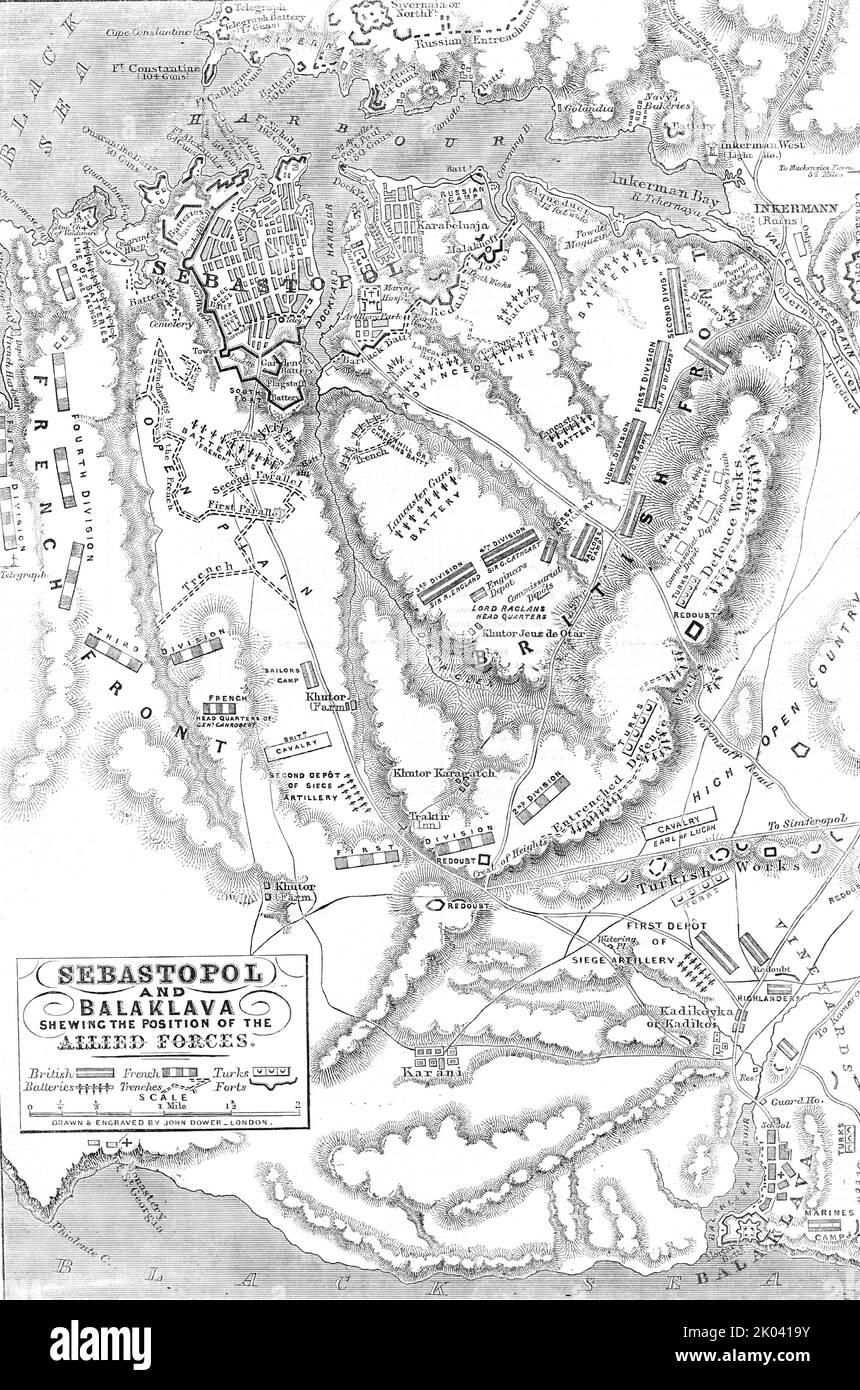 Sebastopol and Balaclava shewing the position of the Allied Forces, 1854. Crimean War. 'The severe and costly battles of Balaclava and Inkerman, and the approach of winter - which will necessarily delay, if not temporarily stop the active siege operations of the Allies - pointed out the necessity of putting the Camp of the latter into an efficient state of defence, by means of complete lines of circumvallation...The object of the two attacks was very different. That of Balaclava was to take the Allied armies in the rear, and cut off their communications with the sea at Balaclava...[The object Stock Photohttps://www.alamy.com/image-license-details/?v=1https://www.alamy.com/sebastopol-and-balaclava-shewing-the-position-of-the-allied-forces-1854-crimean-war-the-severe-and-costly-battles-of-balaclava-and-inkerman-and-the-approach-of-winter-which-will-necessarily-delay-if-not-temporarily-stop-the-active-siege-operations-of-the-allies-pointed-out-the-necessity-of-putting-the-camp-of-the-latter-into-an-efficient-state-of-defence-by-means-of-complete-lines-of-circumvallationthe-object-of-the-two-attacks-was-very-different-that-of-balaclava-was-to-take-the-allied-armies-in-the-rear-and-cut-off-their-communications-with-the-sea-at-balaclava-the-object-image481979175.html
Sebastopol and Balaclava shewing the position of the Allied Forces, 1854. Crimean War. 'The severe and costly battles of Balaclava and Inkerman, and the approach of winter - which will necessarily delay, if not temporarily stop the active siege operations of the Allies - pointed out the necessity of putting the Camp of the latter into an efficient state of defence, by means of complete lines of circumvallation...The object of the two attacks was very different. That of Balaclava was to take the Allied armies in the rear, and cut off their communications with the sea at Balaclava...[The object Stock Photohttps://www.alamy.com/image-license-details/?v=1https://www.alamy.com/sebastopol-and-balaclava-shewing-the-position-of-the-allied-forces-1854-crimean-war-the-severe-and-costly-battles-of-balaclava-and-inkerman-and-the-approach-of-winter-which-will-necessarily-delay-if-not-temporarily-stop-the-active-siege-operations-of-the-allies-pointed-out-the-necessity-of-putting-the-camp-of-the-latter-into-an-efficient-state-of-defence-by-means-of-complete-lines-of-circumvallationthe-object-of-the-two-attacks-was-very-different-that-of-balaclava-was-to-take-the-allied-armies-in-the-rear-and-cut-off-their-communications-with-the-sea-at-balaclava-the-object-image481979175.htmlRM2K0419Y–Sebastopol and Balaclava shewing the position of the Allied Forces, 1854. Crimean War. 'The severe and costly battles of Balaclava and Inkerman, and the approach of winter - which will necessarily delay, if not temporarily stop the active siege operations of the Allies - pointed out the necessity of putting the Camp of the latter into an efficient state of defence, by means of complete lines of circumvallation...The object of the two attacks was very different. That of Balaclava was to take the Allied armies in the rear, and cut off their communications with the sea at Balaclava...[The object
 Aerial view of the aftermath of airstrike on enemy positions in the Demilitarized Zone during the Vietnam War. The image shows extensive system of Viet Cong tunnels and caves at sector YD, located at grid coordinates 149778. This Defense Department photograph was taken in 1966. Stock Photohttps://www.alamy.com/image-license-details/?v=1https://www.alamy.com/aerial-view-of-the-aftermath-of-airstrike-on-enemy-positions-in-the-demilitarized-zone-during-the-vietnam-war-the-image-shows-extensive-system-of-viet-cong-tunnels-and-caves-at-sector-yd-located-at-grid-coordinates-149778-this-defense-department-photograph-was-taken-in-1966-image574140369.html
Aerial view of the aftermath of airstrike on enemy positions in the Demilitarized Zone during the Vietnam War. The image shows extensive system of Viet Cong tunnels and caves at sector YD, located at grid coordinates 149778. This Defense Department photograph was taken in 1966. Stock Photohttps://www.alamy.com/image-license-details/?v=1https://www.alamy.com/aerial-view-of-the-aftermath-of-airstrike-on-enemy-positions-in-the-demilitarized-zone-during-the-vietnam-war-the-image-shows-extensive-system-of-viet-cong-tunnels-and-caves-at-sector-yd-located-at-grid-coordinates-149778-this-defense-department-photograph-was-taken-in-1966-image574140369.htmlRM2TA29W5–Aerial view of the aftermath of airstrike on enemy positions in the Demilitarized Zone during the Vietnam War. The image shows extensive system of Viet Cong tunnels and caves at sector YD, located at grid coordinates 149778. This Defense Department photograph was taken in 1966.
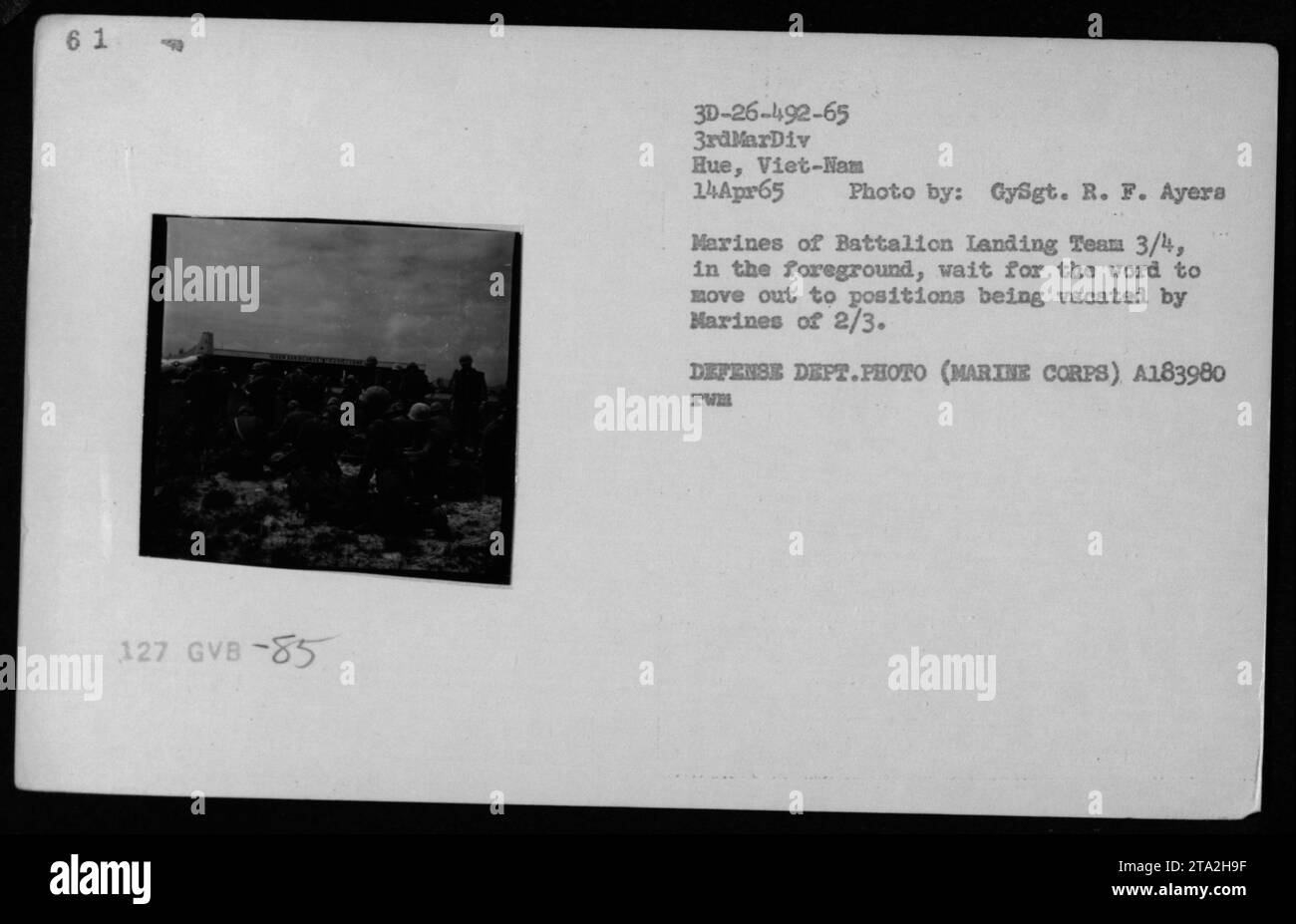 Marines from Battalion Landing Team 3/4 wait for orders to move out and occupy positions being left by Marines from 2/3 on April 14, 1965. This photograph was taken in Hue, Vietnam by GySgt. R. F. Ayers, a part of the 3rd Marine Division. Stock Photohttps://www.alamy.com/image-license-details/?v=1https://www.alamy.com/marines-from-battalion-landing-team-34-wait-for-orders-to-move-out-and-occupy-positions-being-left-by-marines-from-23-on-april-14-1965-this-photograph-was-taken-in-hue-vietnam-by-gysgt-r-f-ayers-a-part-of-the-3rd-marine-division-image574146203.html
Marines from Battalion Landing Team 3/4 wait for orders to move out and occupy positions being left by Marines from 2/3 on April 14, 1965. This photograph was taken in Hue, Vietnam by GySgt. R. F. Ayers, a part of the 3rd Marine Division. Stock Photohttps://www.alamy.com/image-license-details/?v=1https://www.alamy.com/marines-from-battalion-landing-team-34-wait-for-orders-to-move-out-and-occupy-positions-being-left-by-marines-from-23-on-april-14-1965-this-photograph-was-taken-in-hue-vietnam-by-gysgt-r-f-ayers-a-part-of-the-3rd-marine-division-image574146203.htmlRM2TA2H9F–Marines from Battalion Landing Team 3/4 wait for orders to move out and occupy positions being left by Marines from 2/3 on April 14, 1965. This photograph was taken in Hue, Vietnam by GySgt. R. F. Ayers, a part of the 3rd Marine Division.
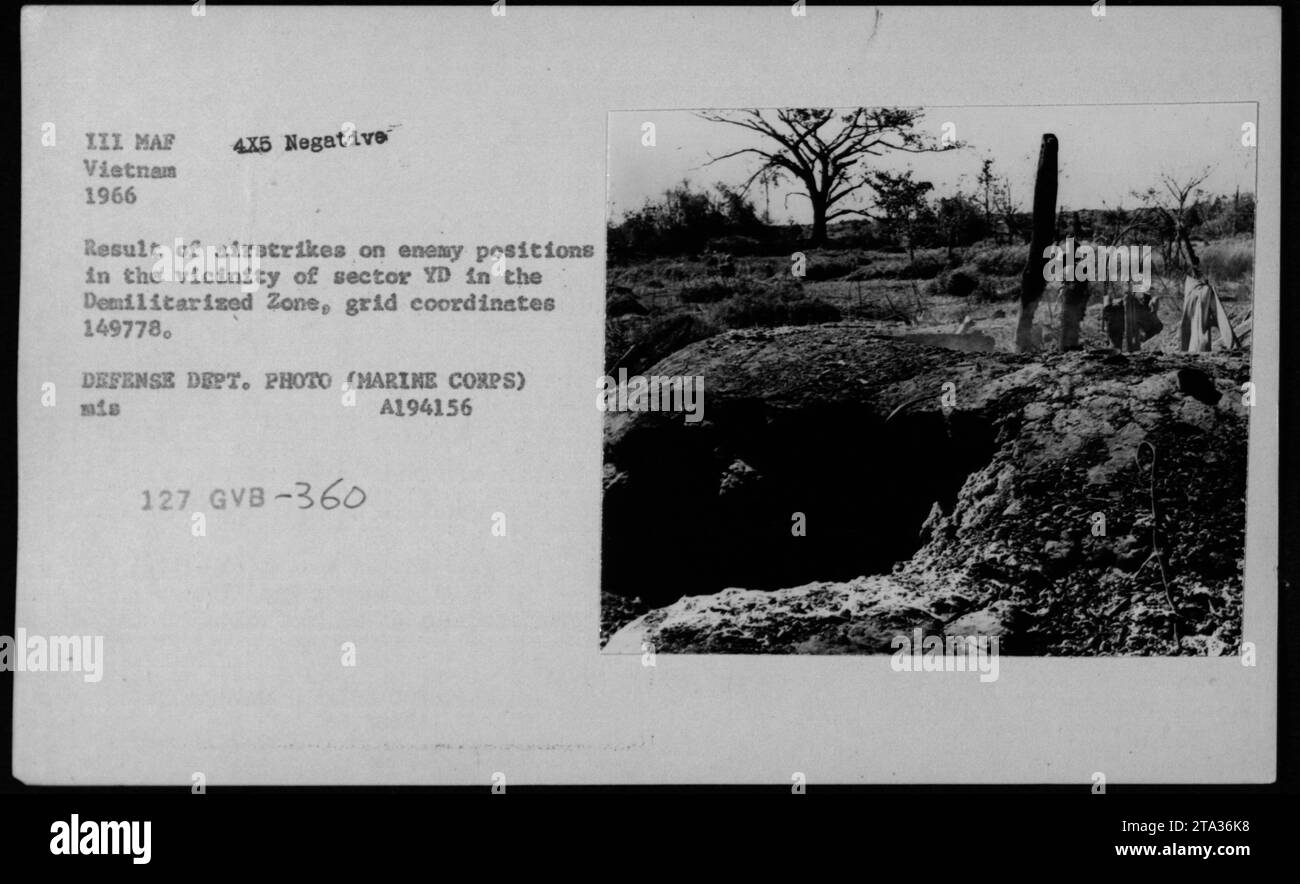 F-105 Thunderchief aircraft conducts airstrikes on enemy positions in sector YD of the Demilitarized Zone (DMZ) in Vietnam. The image shows the aftermath of the airstrikes, revealing tunnels and caves used by the Viet Cong for shelter and concealment. This photograph was taken in 1966 and is part of the III MAF Vietnam collection. Stock Photohttps://www.alamy.com/image-license-details/?v=1https://www.alamy.com/f-105-thunderchief-aircraft-conducts-airstrikes-on-enemy-positions-in-sector-yd-of-the-demilitarized-zone-dmz-in-vietnam-the-image-shows-the-aftermath-of-the-airstrikes-revealing-tunnels-and-caves-used-by-the-viet-cong-for-shelter-and-concealment-this-photograph-was-taken-in-1966-and-is-part-of-the-iii-maf-vietnam-collection-image574159804.html
F-105 Thunderchief aircraft conducts airstrikes on enemy positions in sector YD of the Demilitarized Zone (DMZ) in Vietnam. The image shows the aftermath of the airstrikes, revealing tunnels and caves used by the Viet Cong for shelter and concealment. This photograph was taken in 1966 and is part of the III MAF Vietnam collection. Stock Photohttps://www.alamy.com/image-license-details/?v=1https://www.alamy.com/f-105-thunderchief-aircraft-conducts-airstrikes-on-enemy-positions-in-sector-yd-of-the-demilitarized-zone-dmz-in-vietnam-the-image-shows-the-aftermath-of-the-airstrikes-revealing-tunnels-and-caves-used-by-the-viet-cong-for-shelter-and-concealment-this-photograph-was-taken-in-1966-and-is-part-of-the-iii-maf-vietnam-collection-image574159804.htmlRM2TA36K8–F-105 Thunderchief aircraft conducts airstrikes on enemy positions in sector YD of the Demilitarized Zone (DMZ) in Vietnam. The image shows the aftermath of the airstrikes, revealing tunnels and caves used by the Viet Cong for shelter and concealment. This photograph was taken in 1966 and is part of the III MAF Vietnam collection.
 Marines of 1st Battalion, First Marine Regiment, 1st Marine Division relay information by radio on enemy positions during Operation Calhoun in Vietnam on July 2, 1967. The operation occurred 20 miles south of Dallang. Photograph credited to SSgt. Lewis and sourced from the Defense Department. Stock Photohttps://www.alamy.com/image-license-details/?v=1https://www.alamy.com/marines-of-1st-battalion-first-marine-regiment-1st-marine-division-relay-information-by-radio-on-enemy-positions-during-operation-calhoun-in-vietnam-on-july-2-1967-the-operation-occurred-20-miles-south-of-dallang-photograph-credited-to-ssgt-lewis-and-sourced-from-the-defense-department-image574140552.html
Marines of 1st Battalion, First Marine Regiment, 1st Marine Division relay information by radio on enemy positions during Operation Calhoun in Vietnam on July 2, 1967. The operation occurred 20 miles south of Dallang. Photograph credited to SSgt. Lewis and sourced from the Defense Department. Stock Photohttps://www.alamy.com/image-license-details/?v=1https://www.alamy.com/marines-of-1st-battalion-first-marine-regiment-1st-marine-division-relay-information-by-radio-on-enemy-positions-during-operation-calhoun-in-vietnam-on-july-2-1967-the-operation-occurred-20-miles-south-of-dallang-photograph-credited-to-ssgt-lewis-and-sourced-from-the-defense-department-image574140552.htmlRM2TA2A3M–Marines of 1st Battalion, First Marine Regiment, 1st Marine Division relay information by radio on enemy positions during Operation Calhoun in Vietnam on July 2, 1967. The operation occurred 20 miles south of Dallang. Photograph credited to SSgt. Lewis and sourced from the Defense Department.
 U.S. Marines from 'B' Company, 1st Battalion, Seventh Marines, cross a river in the Viet Nam War on March 13, 1968. The Marines are advancing to new positions during combat operations. This photograph was taken by D. J. Brusch and is part of a Defense Department collection documenting American military activities during the Vietnam War. Stock Photohttps://www.alamy.com/image-license-details/?v=1https://www.alamy.com/us-marines-from-b-company-1st-battalion-seventh-marines-cross-a-river-in-the-viet-nam-war-on-march-13-1968-the-marines-are-advancing-to-new-positions-during-combat-operations-this-photograph-was-taken-by-d-j-brusch-and-is-part-of-a-defense-department-collection-documenting-american-military-activities-during-the-vietnam-war-image574149133.html
U.S. Marines from 'B' Company, 1st Battalion, Seventh Marines, cross a river in the Viet Nam War on March 13, 1968. The Marines are advancing to new positions during combat operations. This photograph was taken by D. J. Brusch and is part of a Defense Department collection documenting American military activities during the Vietnam War. Stock Photohttps://www.alamy.com/image-license-details/?v=1https://www.alamy.com/us-marines-from-b-company-1st-battalion-seventh-marines-cross-a-river-in-the-viet-nam-war-on-march-13-1968-the-marines-are-advancing-to-new-positions-during-combat-operations-this-photograph-was-taken-by-d-j-brusch-and-is-part-of-a-defense-department-collection-documenting-american-military-activities-during-the-vietnam-war-image574149133.htmlRM2TA2N25–U.S. Marines from 'B' Company, 1st Battalion, Seventh Marines, cross a river in the Viet Nam War on March 13, 1968. The Marines are advancing to new positions during combat operations. This photograph was taken by D. J. Brusch and is part of a Defense Department collection documenting American military activities during the Vietnam War.
 U.S. Marines conducting a combat operation known as Operation Meade River in 1968 during the Vietnam War. In this photograph, Marines are seen advancing on enemy positions. The image was captured by Corporal J.D. Gallo and is part of the Defense Department's collection of Vietnam War photographs. Stock Photohttps://www.alamy.com/image-license-details/?v=1https://www.alamy.com/us-marines-conducting-a-combat-operation-known-as-operation-meade-river-in-1968-during-the-vietnam-war-in-this-photograph-marines-are-seen-advancing-on-enemy-positions-the-image-was-captured-by-corporal-jd-gallo-and-is-part-of-the-defense-departments-collection-of-vietnam-war-photographs-image574154946.html
U.S. Marines conducting a combat operation known as Operation Meade River in 1968 during the Vietnam War. In this photograph, Marines are seen advancing on enemy positions. The image was captured by Corporal J.D. Gallo and is part of the Defense Department's collection of Vietnam War photographs. Stock Photohttps://www.alamy.com/image-license-details/?v=1https://www.alamy.com/us-marines-conducting-a-combat-operation-known-as-operation-meade-river-in-1968-during-the-vietnam-war-in-this-photograph-marines-are-seen-advancing-on-enemy-positions-the-image-was-captured-by-corporal-jd-gallo-and-is-part-of-the-defense-departments-collection-of-vietnam-war-photographs-image574154946.htmlRM2TA30DP–U.S. Marines conducting a combat operation known as Operation Meade River in 1968 during the Vietnam War. In this photograph, Marines are seen advancing on enemy positions. The image was captured by Corporal J.D. Gallo and is part of the Defense Department's collection of Vietnam War photographs.
 'In this photograph taken on February 1, 1967, during Operation DeSoto, Second Lieutenant V.C. Thomas, Platoon Commander of the 2nd Platoon, 'I' Company, 3rd Battalion, 7th Marines is seen calling in an air strike against fortified Viet Cong positions. The operation took place south of Quang Ngai province. Photo by Pfc Porter, Defense Department (Marine Corps), A369745.' Stock Photohttps://www.alamy.com/image-license-details/?v=1https://www.alamy.com/in-this-photograph-taken-on-february-1-1967-during-operation-desoto-second-lieutenant-vc-thomas-platoon-commander-of-the-2nd-platoon-i-company-3rd-battalion-7th-marines-is-seen-calling-in-an-air-strike-against-fortified-viet-cong-positions-the-operation-took-place-south-of-quang-ngai-province-photo-by-pfc-porter-defense-department-marine-corps-a369745-image574144116.html
'In this photograph taken on February 1, 1967, during Operation DeSoto, Second Lieutenant V.C. Thomas, Platoon Commander of the 2nd Platoon, 'I' Company, 3rd Battalion, 7th Marines is seen calling in an air strike against fortified Viet Cong positions. The operation took place south of Quang Ngai province. Photo by Pfc Porter, Defense Department (Marine Corps), A369745.' Stock Photohttps://www.alamy.com/image-license-details/?v=1https://www.alamy.com/in-this-photograph-taken-on-february-1-1967-during-operation-desoto-second-lieutenant-vc-thomas-platoon-commander-of-the-2nd-platoon-i-company-3rd-battalion-7th-marines-is-seen-calling-in-an-air-strike-against-fortified-viet-cong-positions-the-operation-took-place-south-of-quang-ngai-province-photo-by-pfc-porter-defense-department-marine-corps-a369745-image574144116.htmlRM2TA2EK0–'In this photograph taken on February 1, 1967, during Operation DeSoto, Second Lieutenant V.C. Thomas, Platoon Commander of the 2nd Platoon, 'I' Company, 3rd Battalion, 7th Marines is seen calling in an air strike against fortified Viet Cong positions. The operation took place south of Quang Ngai province. Photo by Pfc Porter, Defense Department (Marine Corps), A369745.'
 Marines from Foxtrot Company, 2nd Battalion, 5th Marines, assume defensive positions as they unload equipment and supplies after crossing a river during Operation New Castle. The photograph was taken on March 26, 1967. Stock Photohttps://www.alamy.com/image-license-details/?v=1https://www.alamy.com/marines-from-foxtrot-company-2nd-battalion-5th-marines-assume-defensive-positions-as-they-unload-equipment-and-supplies-after-crossing-a-river-during-operation-new-castle-the-photograph-was-taken-on-march-26-1967-image574169517.html
Marines from Foxtrot Company, 2nd Battalion, 5th Marines, assume defensive positions as they unload equipment and supplies after crossing a river during Operation New Castle. The photograph was taken on March 26, 1967. Stock Photohttps://www.alamy.com/image-license-details/?v=1https://www.alamy.com/marines-from-foxtrot-company-2nd-battalion-5th-marines-assume-defensive-positions-as-they-unload-equipment-and-supplies-after-crossing-a-river-during-operation-new-castle-the-photograph-was-taken-on-march-26-1967-image574169517.htmlRM2TA3K25–Marines from Foxtrot Company, 2nd Battalion, 5th Marines, assume defensive positions as they unload equipment and supplies after crossing a river during Operation New Castle. The photograph was taken on March 26, 1967.
 Entrance to a bunker on Hill 881 North, Vietnam during the Vietnam War. The bunker is believed to be used by the Viet Cong and shows the complex system of tunnels and caves they utilized for camouflage and protection against enemy forces. Photograph taken in 1966 by the Department of Defense (Marine Corps). Stock Photohttps://www.alamy.com/image-license-details/?v=1https://www.alamy.com/entrance-to-a-bunker-on-hill-881-north-vietnam-during-the-vietnam-war-the-bunker-is-believed-to-be-used-by-the-viet-cong-and-shows-the-complex-system-of-tunnels-and-caves-they-utilized-for-camouflage-and-protection-against-enemy-forces-photograph-taken-in-1966-by-the-department-of-defense-marine-corps-image574139180.html
Entrance to a bunker on Hill 881 North, Vietnam during the Vietnam War. The bunker is believed to be used by the Viet Cong and shows the complex system of tunnels and caves they utilized for camouflage and protection against enemy forces. Photograph taken in 1966 by the Department of Defense (Marine Corps). Stock Photohttps://www.alamy.com/image-license-details/?v=1https://www.alamy.com/entrance-to-a-bunker-on-hill-881-north-vietnam-during-the-vietnam-war-the-bunker-is-believed-to-be-used-by-the-viet-cong-and-shows-the-complex-system-of-tunnels-and-caves-they-utilized-for-camouflage-and-protection-against-enemy-forces-photograph-taken-in-1966-by-the-department-of-defense-marine-corps-image574139180.htmlRM2TA28AM–Entrance to a bunker on Hill 881 North, Vietnam during the Vietnam War. The bunker is believed to be used by the Viet Cong and shows the complex system of tunnels and caves they utilized for camouflage and protection against enemy forces. Photograph taken in 1966 by the Department of Defense (Marine Corps).
 Soldiers from the 3rd Marine Division, Fleet Marine Force, are seen in this photograph digging defensive positions around the Marine Airfield in Danang, Vietnam. The image, taken by Marine Corps photographer C.R. Besan, shows personnel constructing bunkers and firebases as part of their efforts to fortify the area. Stock Photohttps://www.alamy.com/image-license-details/?v=1https://www.alamy.com/soldiers-from-the-3rd-marine-division-fleet-marine-force-are-seen-in-this-photograph-digging-defensive-positions-around-the-marine-airfield-in-danang-vietnam-the-image-taken-by-marine-corps-photographer-cr-besan-shows-personnel-constructing-bunkers-and-firebases-as-part-of-their-efforts-to-fortify-the-area-image574167111.html
Soldiers from the 3rd Marine Division, Fleet Marine Force, are seen in this photograph digging defensive positions around the Marine Airfield in Danang, Vietnam. The image, taken by Marine Corps photographer C.R. Besan, shows personnel constructing bunkers and firebases as part of their efforts to fortify the area. Stock Photohttps://www.alamy.com/image-license-details/?v=1https://www.alamy.com/soldiers-from-the-3rd-marine-division-fleet-marine-force-are-seen-in-this-photograph-digging-defensive-positions-around-the-marine-airfield-in-danang-vietnam-the-image-taken-by-marine-corps-photographer-cr-besan-shows-personnel-constructing-bunkers-and-firebases-as-part-of-their-efforts-to-fortify-the-area-image574167111.htmlRM2TA3G07–Soldiers from the 3rd Marine Division, Fleet Marine Force, are seen in this photograph digging defensive positions around the Marine Airfield in Danang, Vietnam. The image, taken by Marine Corps photographer C.R. Besan, shows personnel constructing bunkers and firebases as part of their efforts to fortify the area.
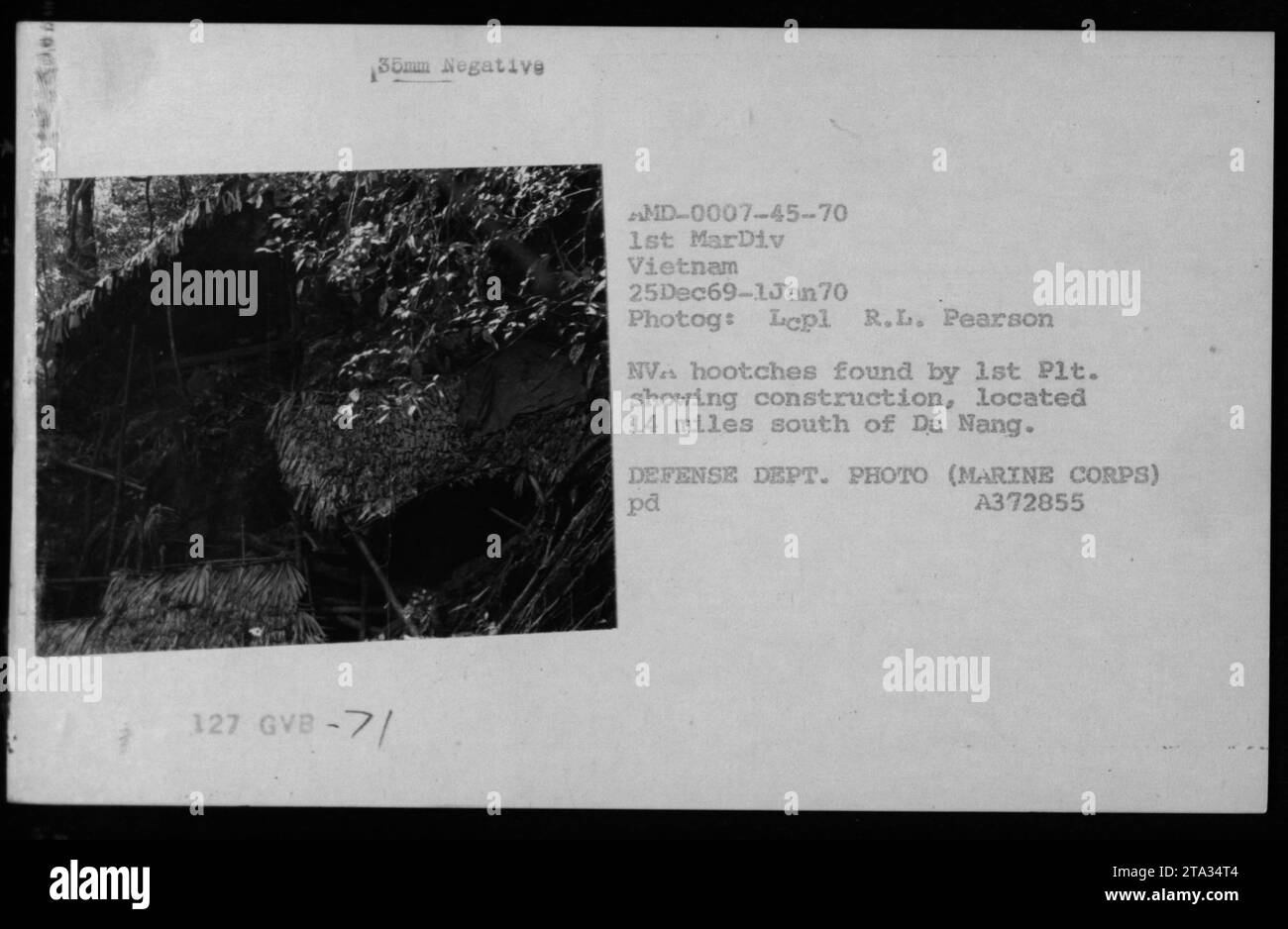 'NVA hootches discovered by 1st Platoon, 1st Marine Division, Vietnam on December 25, 1969. The photograph shows captured weapons and a construction layout of the hootches located 14 miles south of Da Nang. Image taken by R.L. Pearson, Department of Defense photographer.' Stock Photohttps://www.alamy.com/image-license-details/?v=1https://www.alamy.com/nva-hootches-discovered-by-1st-platoon-1st-marine-division-vietnam-on-december-25-1969-the-photograph-shows-captured-weapons-and-a-construction-layout-of-the-hootches-located-14-miles-south-of-da-nang-image-taken-by-rl-pearson-department-of-defense-photographer-image574158372.html
'NVA hootches discovered by 1st Platoon, 1st Marine Division, Vietnam on December 25, 1969. The photograph shows captured weapons and a construction layout of the hootches located 14 miles south of Da Nang. Image taken by R.L. Pearson, Department of Defense photographer.' Stock Photohttps://www.alamy.com/image-license-details/?v=1https://www.alamy.com/nva-hootches-discovered-by-1st-platoon-1st-marine-division-vietnam-on-december-25-1969-the-photograph-shows-captured-weapons-and-a-construction-layout-of-the-hootches-located-14-miles-south-of-da-nang-image-taken-by-rl-pearson-department-of-defense-photographer-image574158372.htmlRM2TA34T4–'NVA hootches discovered by 1st Platoon, 1st Marine Division, Vietnam on December 25, 1969. The photograph shows captured weapons and a construction layout of the hootches located 14 miles south of Da Nang. Image taken by R.L. Pearson, Department of Defense photographer.'
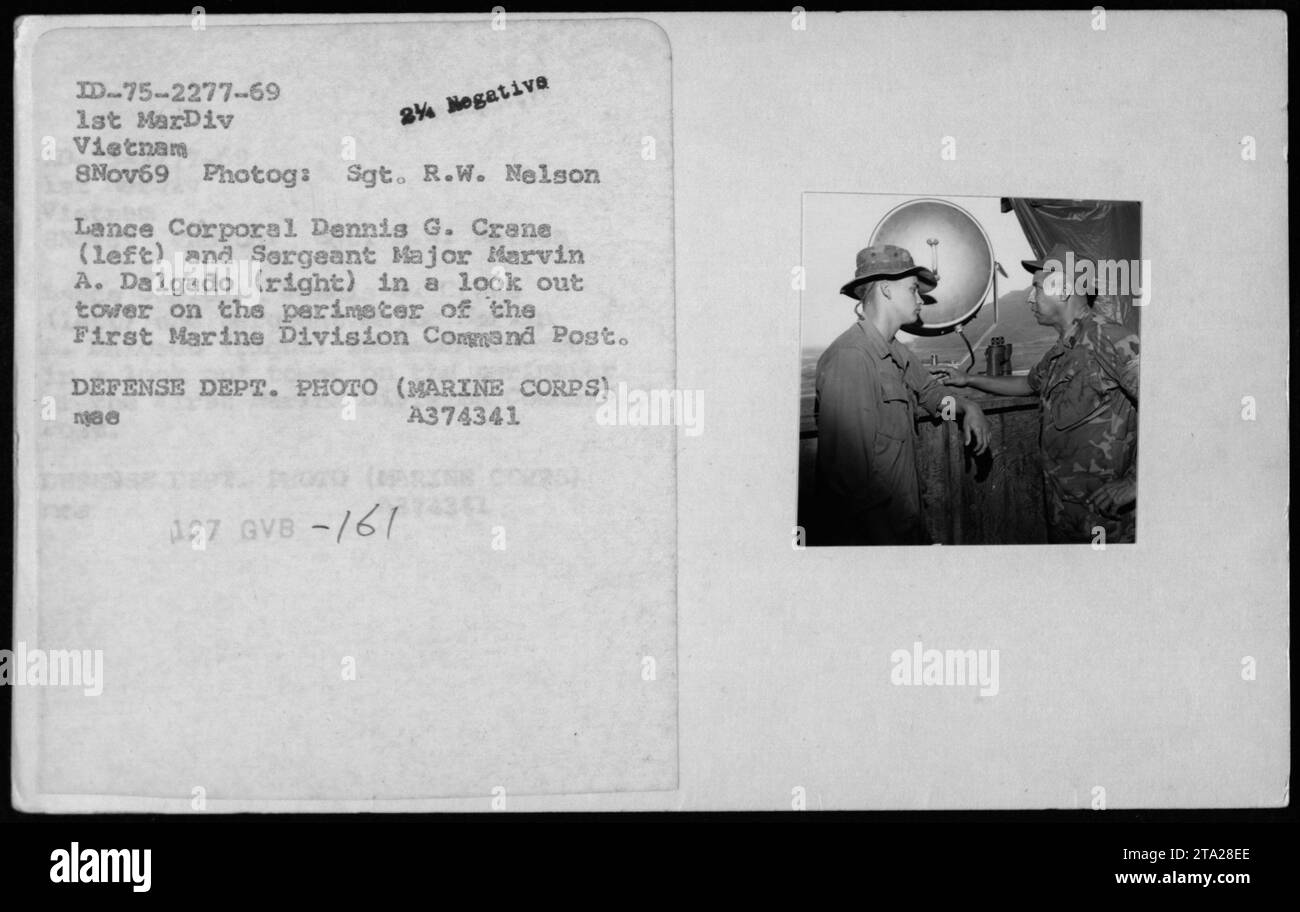 Lance Corporal Dennis G. Crane (left) and Sergeant Major Marvin A. Dalgado (right) stationed at the First Marine Division Command Post in Vietnam on November 8, 1969. They are seen in a lookout tower on the perimeter of the base, keeping a watchful eye on the surroundings. Photograph by Sgt. R.W. Nelson. DEFENSE DEPT. PHOTO (MARINE CORPS). Stock Photohttps://www.alamy.com/image-license-details/?v=1https://www.alamy.com/lance-corporal-dennis-g-crane-left-and-sergeant-major-marvin-a-dalgado-right-stationed-at-the-first-marine-division-command-post-in-vietnam-on-november-8-1969-they-are-seen-in-a-lookout-tower-on-the-perimeter-of-the-base-keeping-a-watchful-eye-on-the-surroundings-photograph-by-sgt-rw-nelson-defense-dept-photo-marine-corps-image574139286.html
Lance Corporal Dennis G. Crane (left) and Sergeant Major Marvin A. Dalgado (right) stationed at the First Marine Division Command Post in Vietnam on November 8, 1969. They are seen in a lookout tower on the perimeter of the base, keeping a watchful eye on the surroundings. Photograph by Sgt. R.W. Nelson. DEFENSE DEPT. PHOTO (MARINE CORPS). Stock Photohttps://www.alamy.com/image-license-details/?v=1https://www.alamy.com/lance-corporal-dennis-g-crane-left-and-sergeant-major-marvin-a-dalgado-right-stationed-at-the-first-marine-division-command-post-in-vietnam-on-november-8-1969-they-are-seen-in-a-lookout-tower-on-the-perimeter-of-the-base-keeping-a-watchful-eye-on-the-surroundings-photograph-by-sgt-rw-nelson-defense-dept-photo-marine-corps-image574139286.htmlRM2TA28EE–Lance Corporal Dennis G. Crane (left) and Sergeant Major Marvin A. Dalgado (right) stationed at the First Marine Division Command Post in Vietnam on November 8, 1969. They are seen in a lookout tower on the perimeter of the base, keeping a watchful eye on the surroundings. Photograph by Sgt. R.W. Nelson. DEFENSE DEPT. PHOTO (MARINE CORPS).
 A close-up image showing an opening in one of the bunkers located on Hill 881 South during the Vietnam War. These bunkers were part of a network of tunnels and caves utilized by the Viet Cong. This photograph was taken in 1966 by the Defense Department and is marked as A194152. Stock Photohttps://www.alamy.com/image-license-details/?v=1https://www.alamy.com/a-close-up-image-showing-an-opening-in-one-of-the-bunkers-located-on-hill-881-south-during-the-vietnam-war-these-bunkers-were-part-of-a-network-of-tunnels-and-caves-utilized-by-the-viet-cong-this-photograph-was-taken-in-1966-by-the-defense-department-and-is-marked-as-a194152-image574141798.html
A close-up image showing an opening in one of the bunkers located on Hill 881 South during the Vietnam War. These bunkers were part of a network of tunnels and caves utilized by the Viet Cong. This photograph was taken in 1966 by the Defense Department and is marked as A194152. Stock Photohttps://www.alamy.com/image-license-details/?v=1https://www.alamy.com/a-close-up-image-showing-an-opening-in-one-of-the-bunkers-located-on-hill-881-south-during-the-vietnam-war-these-bunkers-were-part-of-a-network-of-tunnels-and-caves-utilized-by-the-viet-cong-this-photograph-was-taken-in-1966-by-the-defense-department-and-is-marked-as-a194152-image574141798.htmlRM2TA2BM6–A close-up image showing an opening in one of the bunkers located on Hill 881 South during the Vietnam War. These bunkers were part of a network of tunnels and caves utilized by the Viet Cong. This photograph was taken in 1966 by the Defense Department and is marked as A194152.
 Overlooking Brou Village and the Khe Sanh Airstrip from Hill 90, an overall view of the village and the surrounding structures can be seen. This photograph gives a glimpse of the US Marine Corps and Vietnamese buildings and bunkers in the area. It was taken on January 13, 1968, during the Vietnam War. Stock Photohttps://www.alamy.com/image-license-details/?v=1https://www.alamy.com/overlooking-brou-village-and-the-khe-sanh-airstrip-from-hill-90-an-overall-view-of-the-village-and-the-surrounding-structures-can-be-seen-this-photograph-gives-a-glimpse-of-the-us-marine-corps-and-vietnamese-buildings-and-bunkers-in-the-area-it-was-taken-on-january-13-1968-during-the-vietnam-war-image574173144.html
Overlooking Brou Village and the Khe Sanh Airstrip from Hill 90, an overall view of the village and the surrounding structures can be seen. This photograph gives a glimpse of the US Marine Corps and Vietnamese buildings and bunkers in the area. It was taken on January 13, 1968, during the Vietnam War. Stock Photohttps://www.alamy.com/image-license-details/?v=1https://www.alamy.com/overlooking-brou-village-and-the-khe-sanh-airstrip-from-hill-90-an-overall-view-of-the-village-and-the-surrounding-structures-can-be-seen-this-photograph-gives-a-glimpse-of-the-us-marine-corps-and-vietnamese-buildings-and-bunkers-in-the-area-it-was-taken-on-january-13-1968-during-the-vietnam-war-image574173144.htmlRM2TA3RKM–Overlooking Brou Village and the Khe Sanh Airstrip from Hill 90, an overall view of the village and the surrounding structures can be seen. This photograph gives a glimpse of the US Marine Corps and Vietnamese buildings and bunkers in the area. It was taken on January 13, 1968, during the Vietnam War.
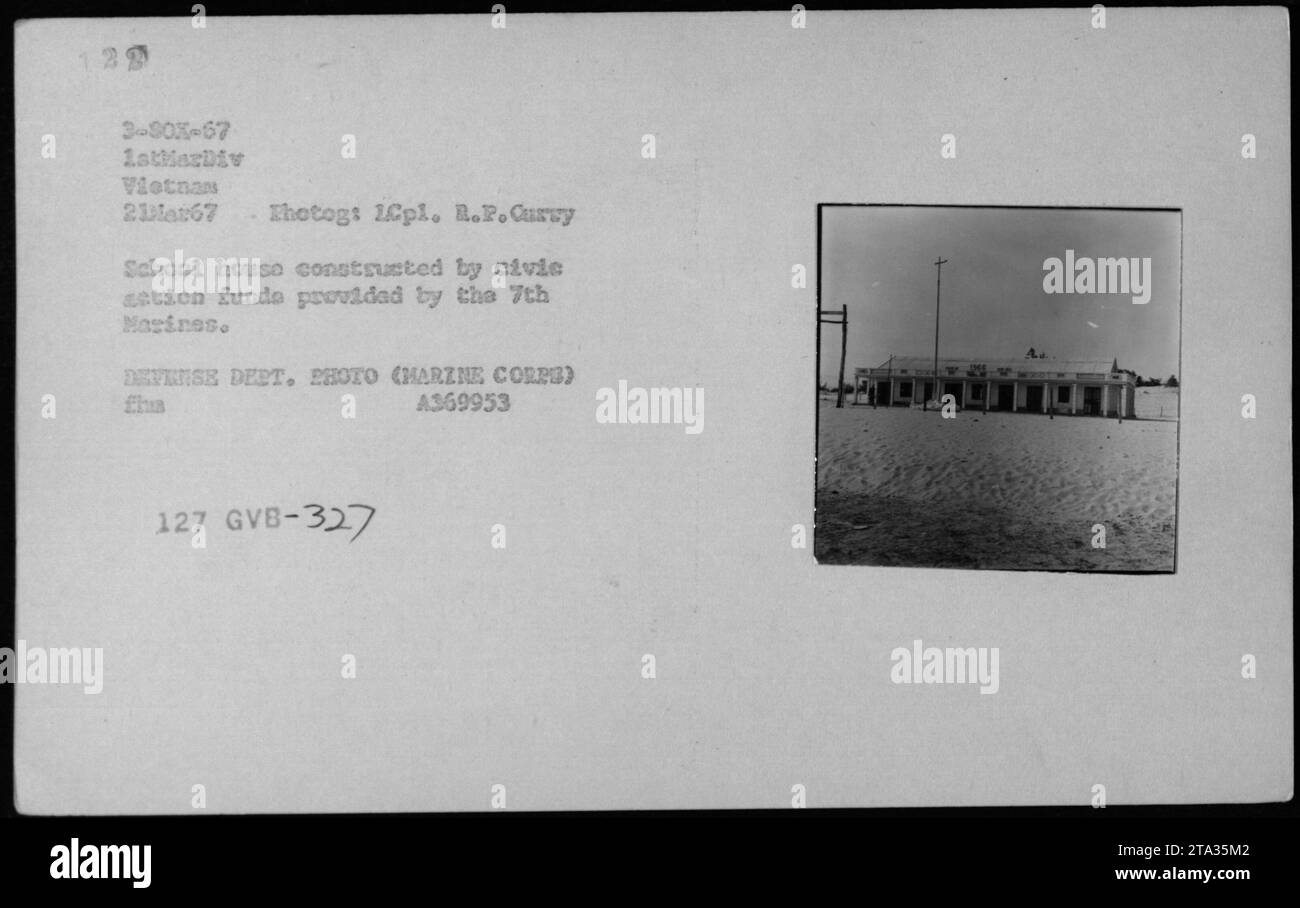 View of USMC and Vietnamese buildings and bunkers on March 21, 1967. The image shows a school house constructed by the civic section funded by the 7th Marines during the Vietnam War. This is a Defense Department photo taken by 1st Corporal F. Curry. Stock Photohttps://www.alamy.com/image-license-details/?v=1https://www.alamy.com/view-of-usmc-and-vietnamese-buildings-and-bunkers-on-march-21-1967-the-image-shows-a-school-house-constructed-by-the-civic-section-funded-by-the-7th-marines-during-the-vietnam-war-this-is-a-defense-department-photo-taken-by-1st-corporal-f-curry-image574159042.html
View of USMC and Vietnamese buildings and bunkers on March 21, 1967. The image shows a school house constructed by the civic section funded by the 7th Marines during the Vietnam War. This is a Defense Department photo taken by 1st Corporal F. Curry. Stock Photohttps://www.alamy.com/image-license-details/?v=1https://www.alamy.com/view-of-usmc-and-vietnamese-buildings-and-bunkers-on-march-21-1967-the-image-shows-a-school-house-constructed-by-the-civic-section-funded-by-the-7th-marines-during-the-vietnam-war-this-is-a-defense-department-photo-taken-by-1st-corporal-f-curry-image574159042.htmlRM2TA35M2–View of USMC and Vietnamese buildings and bunkers on March 21, 1967. The image shows a school house constructed by the civic section funded by the 7th Marines during the Vietnam War. This is a Defense Department photo taken by 1st Corporal F. Curry.
 Marines from D Company, 1st Battalion, 7th Marines, occupy a trench previously dug by the Viet Cong. The photograph was taken on August 22, 1965, during Operation 'Starlight' on the Van Troung Peninsula in Vietnam. The Marines overran the Viet Cong position after engaging in combat. Stock Photohttps://www.alamy.com/image-license-details/?v=1https://www.alamy.com/marines-from-d-company-1st-battalion-7th-marines-occupy-a-trench-previously-dug-by-the-viet-cong-the-photograph-was-taken-on-august-22-1965-during-operation-starlight-on-the-van-troung-peninsula-in-vietnam-the-marines-overran-the-viet-cong-position-after-engaging-in-combat-image574167016.html
Marines from D Company, 1st Battalion, 7th Marines, occupy a trench previously dug by the Viet Cong. The photograph was taken on August 22, 1965, during Operation 'Starlight' on the Van Troung Peninsula in Vietnam. The Marines overran the Viet Cong position after engaging in combat. Stock Photohttps://www.alamy.com/image-license-details/?v=1https://www.alamy.com/marines-from-d-company-1st-battalion-7th-marines-occupy-a-trench-previously-dug-by-the-viet-cong-the-photograph-was-taken-on-august-22-1965-during-operation-starlight-on-the-van-troung-peninsula-in-vietnam-the-marines-overran-the-viet-cong-position-after-engaging-in-combat-image574167016.htmlRM2TA3FTT–Marines from D Company, 1st Battalion, 7th Marines, occupy a trench previously dug by the Viet Cong. The photograph was taken on August 22, 1965, during Operation 'Starlight' on the Van Troung Peninsula in Vietnam. The Marines overran the Viet Cong position after engaging in combat.
 Aerial photograph of the Khe Sanh base taken on September 12, 1967 by SSgt. Thomas N. Bland Jr. The image shows an overhead view of the base. It was captured during the Vietnam War and the photograph is from the Defense Department's Marine Corps collection. Stock Photohttps://www.alamy.com/image-license-details/?v=1https://www.alamy.com/aerial-photograph-of-the-khe-sanh-base-taken-on-september-12-1967-by-ssgt-thomas-n-bland-jr-the-image-shows-an-overhead-view-of-the-base-it-was-captured-during-the-vietnam-war-and-the-photograph-is-from-the-defense-departments-marine-corps-collection-image574151594.html
Aerial photograph of the Khe Sanh base taken on September 12, 1967 by SSgt. Thomas N. Bland Jr. The image shows an overhead view of the base. It was captured during the Vietnam War and the photograph is from the Defense Department's Marine Corps collection. Stock Photohttps://www.alamy.com/image-license-details/?v=1https://www.alamy.com/aerial-photograph-of-the-khe-sanh-base-taken-on-september-12-1967-by-ssgt-thomas-n-bland-jr-the-image-shows-an-overhead-view-of-the-base-it-was-captured-during-the-vietnam-war-and-the-photograph-is-from-the-defense-departments-marine-corps-collection-image574151594.htmlRM2TA2T62–Aerial photograph of the Khe Sanh base taken on September 12, 1967 by SSgt. Thomas N. Bland Jr. The image shows an overhead view of the base. It was captured during the Vietnam War and the photograph is from the Defense Department's Marine Corps collection.
 A Marine from the 2nd Platoon during Operation Skull is shown checking a cave for possible Viet Cong presence. The photograph was taken on October 16, 1965, in the Thanh Troung area, located 10 miles west of Danang. (Photographer: Cpl. Dahl. Source: DEVERSE DEPT.PHOTO, MARIE CORPS, A185929 SER 127 GVB-359) Stock Photohttps://www.alamy.com/image-license-details/?v=1https://www.alamy.com/a-marine-from-the-2nd-platoon-during-operation-skull-is-shown-checking-a-cave-for-possible-viet-cong-presence-the-photograph-was-taken-on-october-16-1965-in-the-thanh-troung-area-located-10-miles-west-of-danang-photographer-cpl-dahl-source-deverse-deptphoto-marie-corps-a185929-ser-127-gvb-359-image574155388.html
A Marine from the 2nd Platoon during Operation Skull is shown checking a cave for possible Viet Cong presence. The photograph was taken on October 16, 1965, in the Thanh Troung area, located 10 miles west of Danang. (Photographer: Cpl. Dahl. Source: DEVERSE DEPT.PHOTO, MARIE CORPS, A185929 SER 127 GVB-359) Stock Photohttps://www.alamy.com/image-license-details/?v=1https://www.alamy.com/a-marine-from-the-2nd-platoon-during-operation-skull-is-shown-checking-a-cave-for-possible-viet-cong-presence-the-photograph-was-taken-on-october-16-1965-in-the-thanh-troung-area-located-10-miles-west-of-danang-photographer-cpl-dahl-source-deverse-deptphoto-marie-corps-a185929-ser-127-gvb-359-image574155388.htmlRM2TA311G–A Marine from the 2nd Platoon during Operation Skull is shown checking a cave for possible Viet Cong presence. The photograph was taken on October 16, 1965, in the Thanh Troung area, located 10 miles west of Danang. (Photographer: Cpl. Dahl. Source: DEVERSE DEPT.PHOTO, MARIE CORPS, A185929 SER 127 GVB-359)
 View of Viet Cong tunnels in Dong Son village during the Vietnam War. This photograph captures the intricate network of tunnels and caves that the Viet Cong used for hiding, shelter, and guerrilla warfare. Taken in August 1965, this image showcases the challenges faced by the American military in combating the Viet Cong insurgency. Stock Photohttps://www.alamy.com/image-license-details/?v=1https://www.alamy.com/view-of-viet-cong-tunnels-in-dong-son-village-during-the-vietnam-war-this-photograph-captures-the-intricate-network-of-tunnels-and-caves-that-the-viet-cong-used-for-hiding-shelter-and-guerrilla-warfare-taken-in-august-1965-this-image-showcases-the-challenges-faced-by-the-american-military-in-combating-the-viet-cong-insurgency-image574156655.html
View of Viet Cong tunnels in Dong Son village during the Vietnam War. This photograph captures the intricate network of tunnels and caves that the Viet Cong used for hiding, shelter, and guerrilla warfare. Taken in August 1965, this image showcases the challenges faced by the American military in combating the Viet Cong insurgency. Stock Photohttps://www.alamy.com/image-license-details/?v=1https://www.alamy.com/view-of-viet-cong-tunnels-in-dong-son-village-during-the-vietnam-war-this-photograph-captures-the-intricate-network-of-tunnels-and-caves-that-the-viet-cong-used-for-hiding-shelter-and-guerrilla-warfare-taken-in-august-1965-this-image-showcases-the-challenges-faced-by-the-american-military-in-combating-the-viet-cong-insurgency-image574156655.htmlRM2TA32JR–View of Viet Cong tunnels in Dong Son village during the Vietnam War. This photograph captures the intricate network of tunnels and caves that the Viet Cong used for hiding, shelter, and guerrilla warfare. Taken in August 1965, this image showcases the challenges faced by the American military in combating the Viet Cong insurgency.
 Marines from 'E' Company, 2nd Battalion, 4th Marines on the move during operation 'Lien Kit-4' near Chu Lai, Vietnam on July 28, 1965. Stock Photohttps://www.alamy.com/image-license-details/?v=1https://www.alamy.com/marines-from-e-company-2nd-battalion-4th-marines-on-the-move-during-operation-lien-kit-4-near-chu-lai-vietnam-on-july-28-1965-image574151667.html
Marines from 'E' Company, 2nd Battalion, 4th Marines on the move during operation 'Lien Kit-4' near Chu Lai, Vietnam on July 28, 1965. Stock Photohttps://www.alamy.com/image-license-details/?v=1https://www.alamy.com/marines-from-e-company-2nd-battalion-4th-marines-on-the-move-during-operation-lien-kit-4-near-chu-lai-vietnam-on-july-28-1965-image574151667.htmlRM2TA2T8K–Marines from 'E' Company, 2nd Battalion, 4th Marines on the move during operation 'Lien Kit-4' near Chu Lai, Vietnam on July 28, 1965.
 A view of a Viet Cong tunnel in Dong Son Village, taken in August 1965. This photograph, coded 34-363-65 and part of the 3rd Marine Division in Vietnam, shows a hidden tunnel utilized by the Viet Cong for military activities. The image was captured by the Defense Department and is classified under the code A184938 W 127 GVB-359. Stock Photohttps://www.alamy.com/image-license-details/?v=1https://www.alamy.com/a-view-of-a-viet-cong-tunnel-in-dong-son-village-taken-in-august-1965-this-photograph-coded-34-363-65-and-part-of-the-3rd-marine-division-in-vietnam-shows-a-hidden-tunnel-utilized-by-the-viet-cong-for-military-activities-the-image-was-captured-by-the-defense-department-and-is-classified-under-the-code-a184938-w-127-gvb-359-image574154187.html
A view of a Viet Cong tunnel in Dong Son Village, taken in August 1965. This photograph, coded 34-363-65 and part of the 3rd Marine Division in Vietnam, shows a hidden tunnel utilized by the Viet Cong for military activities. The image was captured by the Defense Department and is classified under the code A184938 W 127 GVB-359. Stock Photohttps://www.alamy.com/image-license-details/?v=1https://www.alamy.com/a-view-of-a-viet-cong-tunnel-in-dong-son-village-taken-in-august-1965-this-photograph-coded-34-363-65-and-part-of-the-3rd-marine-division-in-vietnam-shows-a-hidden-tunnel-utilized-by-the-viet-cong-for-military-activities-the-image-was-captured-by-the-defense-department-and-is-classified-under-the-code-a184938-w-127-gvb-359-image574154187.htmlRM2TA2YEK–A view of a Viet Cong tunnel in Dong Son Village, taken in August 1965. This photograph, coded 34-363-65 and part of the 3rd Marine Division in Vietnam, shows a hidden tunnel utilized by the Viet Cong for military activities. The image was captured by the Defense Department and is classified under the code A184938 W 127 GVB-359.
 A photograph taken on February 4, 1966, shows a fortified cave and bunker on Nui Coa Mountain in Vietnam. The cave served as a political indoctrination camp for the Viet Cong, where more than 60 villagers were detained at a time. The captors would hold the villagers until they felt complete indoctrination had been achieved. This image was taken by SSgt. K. Kelly and is part of the Photographs of American Military Activities during the Vietnam War collection. Stock Photohttps://www.alamy.com/image-license-details/?v=1https://www.alamy.com/a-photograph-taken-on-february-4-1966-shows-a-fortified-cave-and-bunker-on-nui-coa-mountain-in-vietnam-the-cave-served-as-a-political-indoctrination-camp-for-the-viet-cong-where-more-than-60-villagers-were-detained-at-a-time-the-captors-would-hold-the-villagers-until-they-felt-complete-indoctrination-had-been-achieved-this-image-was-taken-by-ssgt-k-kelly-and-is-part-of-the-photographs-of-american-military-activities-during-the-vietnam-war-collection-image574172794.html
A photograph taken on February 4, 1966, shows a fortified cave and bunker on Nui Coa Mountain in Vietnam. The cave served as a political indoctrination camp for the Viet Cong, where more than 60 villagers were detained at a time. The captors would hold the villagers until they felt complete indoctrination had been achieved. This image was taken by SSgt. K. Kelly and is part of the Photographs of American Military Activities during the Vietnam War collection. Stock Photohttps://www.alamy.com/image-license-details/?v=1https://www.alamy.com/a-photograph-taken-on-february-4-1966-shows-a-fortified-cave-and-bunker-on-nui-coa-mountain-in-vietnam-the-cave-served-as-a-political-indoctrination-camp-for-the-viet-cong-where-more-than-60-villagers-were-detained-at-a-time-the-captors-would-hold-the-villagers-until-they-felt-complete-indoctrination-had-been-achieved-this-image-was-taken-by-ssgt-k-kelly-and-is-part-of-the-photographs-of-american-military-activities-during-the-vietnam-war-collection-image574172794.htmlRM2TA3R76–A photograph taken on February 4, 1966, shows a fortified cave and bunker on Nui Coa Mountain in Vietnam. The cave served as a political indoctrination camp for the Viet Cong, where more than 60 villagers were detained at a time. The captors would hold the villagers until they felt complete indoctrination had been achieved. This image was taken by SSgt. K. Kelly and is part of the Photographs of American Military Activities during the Vietnam War collection.
 A U.S. Marine from the Fourth Infantry Division fires a round from an M79 grenade launcher at a sniper's position in Bus during Operation Hue City in March 1968. The photograph was taken by Lepi R. J. Smith and is part of a series documenting American military activities during the Vietnam War. (Defense Department Photo, Archives of the Vietnam War, Accession Number A373668-127) Stock Photohttps://www.alamy.com/image-license-details/?v=1https://www.alamy.com/a-us-marine-from-the-fourth-infantry-division-fires-a-round-from-an-m79-grenade-launcher-at-a-snipers-position-in-bus-during-operation-hue-city-in-march-1968-the-photograph-was-taken-by-lepi-r-j-smith-and-is-part-of-a-series-documenting-american-military-activities-during-the-vietnam-war-defense-department-photo-archives-of-the-vietnam-war-accession-number-a373668-127-image574162890.html
A U.S. Marine from the Fourth Infantry Division fires a round from an M79 grenade launcher at a sniper's position in Bus during Operation Hue City in March 1968. The photograph was taken by Lepi R. J. Smith and is part of a series documenting American military activities during the Vietnam War. (Defense Department Photo, Archives of the Vietnam War, Accession Number A373668-127) Stock Photohttps://www.alamy.com/image-license-details/?v=1https://www.alamy.com/a-us-marine-from-the-fourth-infantry-division-fires-a-round-from-an-m79-grenade-launcher-at-a-snipers-position-in-bus-during-operation-hue-city-in-march-1968-the-photograph-was-taken-by-lepi-r-j-smith-and-is-part-of-a-series-documenting-american-military-activities-during-the-vietnam-war-defense-department-photo-archives-of-the-vietnam-war-accession-number-a373668-127-image574162890.htmlRM2TA3AHE–A U.S. Marine from the Fourth Infantry Division fires a round from an M79 grenade launcher at a sniper's position in Bus during Operation Hue City in March 1968. The photograph was taken by Lepi R. J. Smith and is part of a series documenting American military activities during the Vietnam War. (Defense Department Photo, Archives of the Vietnam War, Accession Number A373668-127)